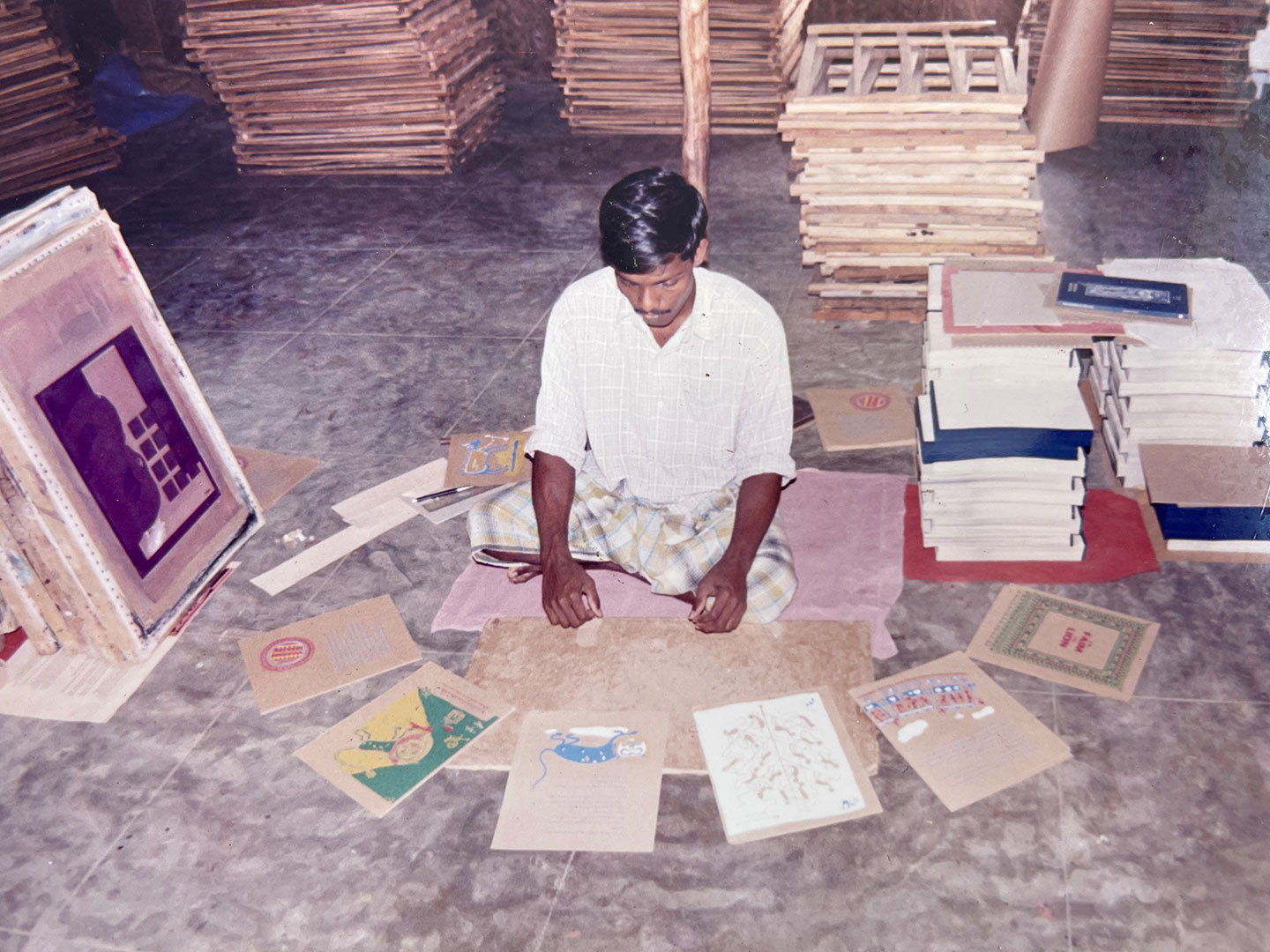
29 Jul The Past is Always Present: 28 Years of Tara Books
by Gita Wolf and V. Geetha
It all began in 1993, at Snehidi: Forum for Women, a feminist collective in Chennai. We were both part of this group, and one day, during the course of conversation, Gita Wolf mentioned that she had been looking for books for her young son, and bemoaned the lack of interesting material for Indian children, especially in English. This set off a lively discussion, and sometime later, Gita came up with an idea: She wanted to start a publishing house for children’s books, based in the Indian context. V. Geetha became part of this enterprise in 1996, and we have since worked together as an editorial team.
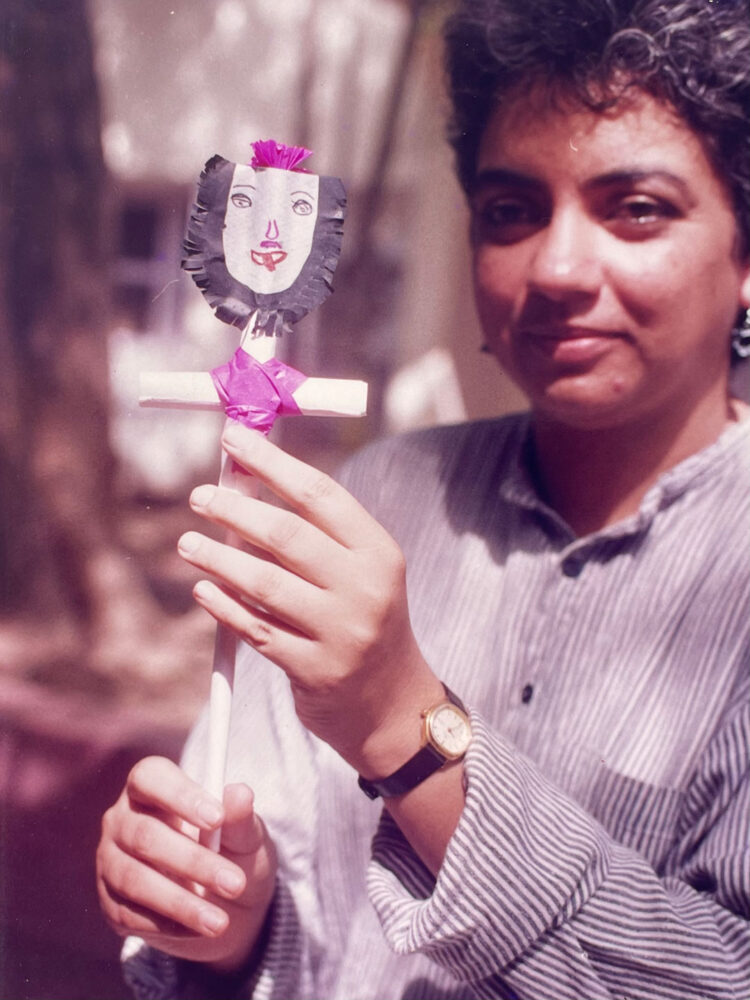
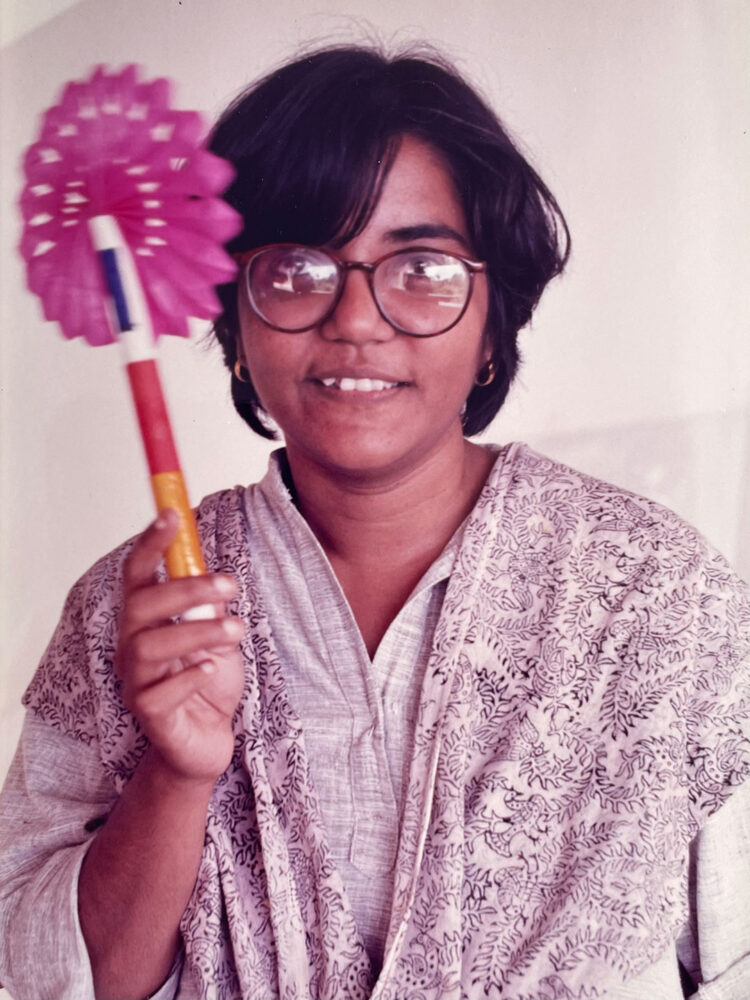
Hard at play: Publisher Gita Wolf and Editorial Director V. Geetha in 1995
Years later, when asked about Tara’s origins, a bemused Gita would say, “I didn’t really have a business plan, nor had I thought through all that publishing involved. My impulse was based on two things: As an avid child-reader mostly fed on Anglo-Saxon books, it seemed to me that fun and adventure seemed to happen only to children in other places… and I wondered, why not right here? So I wanted to create books which would make children want to read — nothing preachy or moralistic. My other interest was in the visual: I was fascinated by picture books. I’ve always loved art, but it was never taken seriously when I was growing up. So art had to be a part of my publishing.
“It was only much later, when Tara took off, and we began working with artists from different indigenous communities to create picture books, that something else dawned on me: These images told stories in a way so different from our own, cutting through language barriers and giving us a rich and direct access to cultures that are so different from our own. That’s how art has come to be central to publishing at Tara.
“As time went on, our interest in picture books for children began to include visual books for adults as well. We explored not only combinations of text and image, but also book forms and production techniques. Design too started to play a big role. All of this happened organically, we’ve grown with new ideas that occur to us, corrected course when we needed to, and evolved with all the creative people we’ve worked with. This has taken us in unexpected directions. Basically — hopefully — we keep learning along the way.”
With experience and skills honed over time, we’ve become increasingly confident in our publishing — we’ve taken on themes and treatments that are complex and challenging, and have put out books we wouldn’t have dreamt of making when we first started. Even so, when Geetha began putting together a chronology of our publishing for this blog, she noticed something remarkable: Looking closely again at our very first books, she discovered uncanny links to what came afterwards. “In retrospect,” she said, “the early books seem to have anticipated all that we came to do, in later years.” Put another way, despite all the varied directions we’ve taken, there appears to be a strong thread of connection running through our years of work. This is best described as a basic set of values and perspectives which have continued to thrive and take on different forms over the decades. But our initial manifesto, so to speak, seems curiously intact.
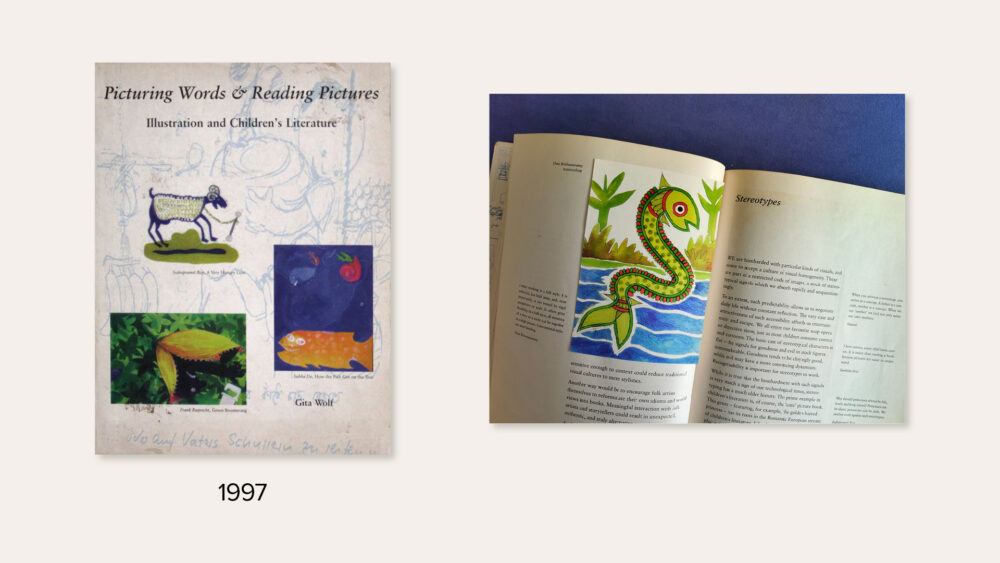
Picturing Words and Reading Pictures — An early publishing manifesto that surprisingly lists enduring concerns
What are these values that remain central to our publishing? Some of them were openly stated, but many were implicit, part of a belief system and a way of functioning that we take for granted. In this blog, we have sought to name and trace enduring aspects of our vision through our publishing timeline, beginning with the earliest books — an exercise that has proved to be very stimulating. We think it will be equally thought-provoking for our readers, and give them a fresh and unexpected lens through which to view our list. The examples we’ve chosen are by way of illustration — they are by no means exhaustive, but we do think the books we have cited help to make our argument.
The titles marked in black are in print and available on our website, the titles marked in grey are now out of print but remain an integral part of our publishing journey.
Feminism
Our uncompromising belief in gender equality was what brought us together as an editorial team, and it is an agenda that remains close to our feminist hearts. Mala, our very first book, featured an intrepid girl who defeats a demon using her wits. We relished not only the reversal of the helpless woman trope so common in fairy tales, but also the use of cleverness in the place of brute physical force. Many of our books feature plucky, intelligent, adventurous and fun-loving girls.
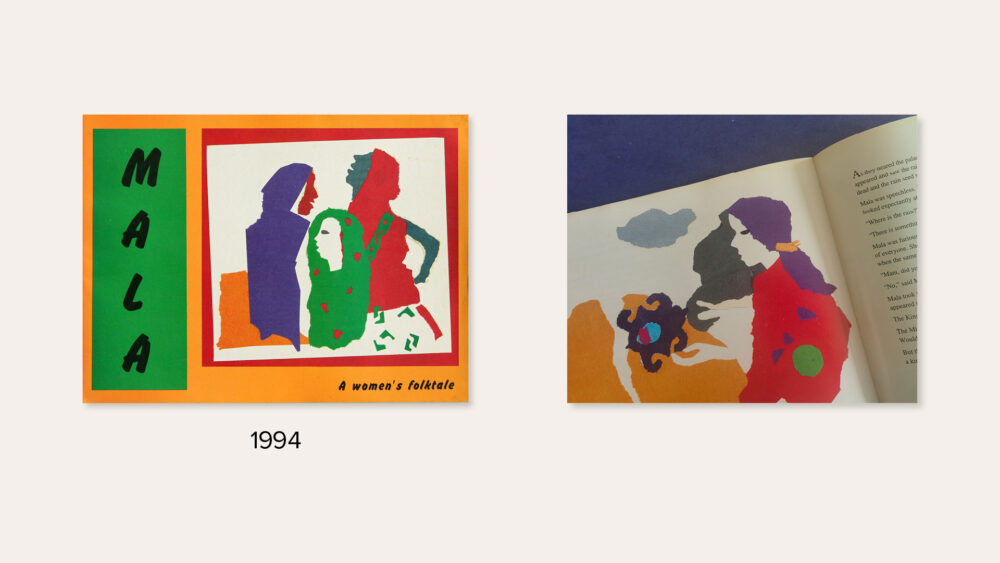
Mala
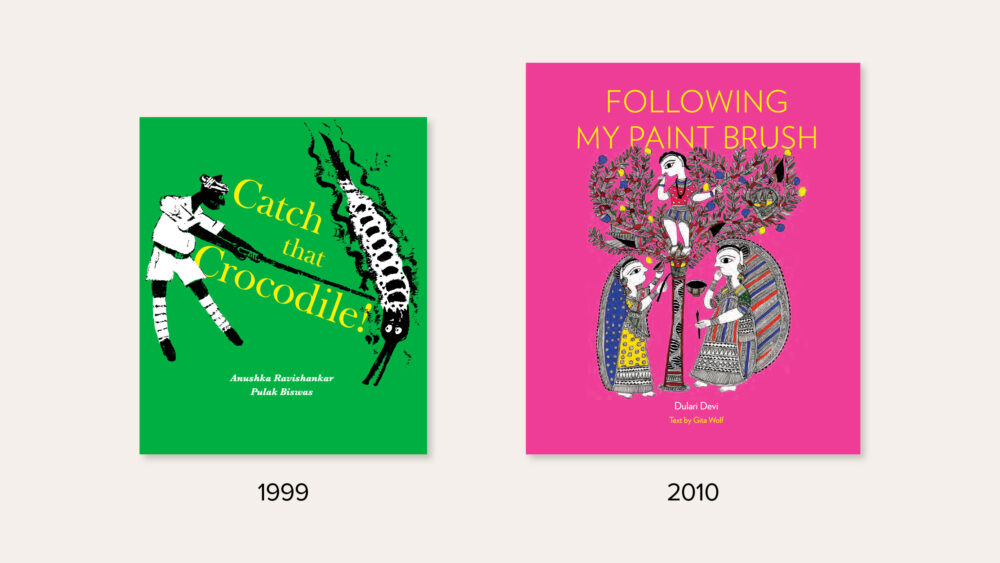
Catch that Crocodile — Humorous tale of a lost crocodile, a village in fear and a smart fisher girl
Following My Paintbrush — A domestic labourer’s moving account of her journey into art
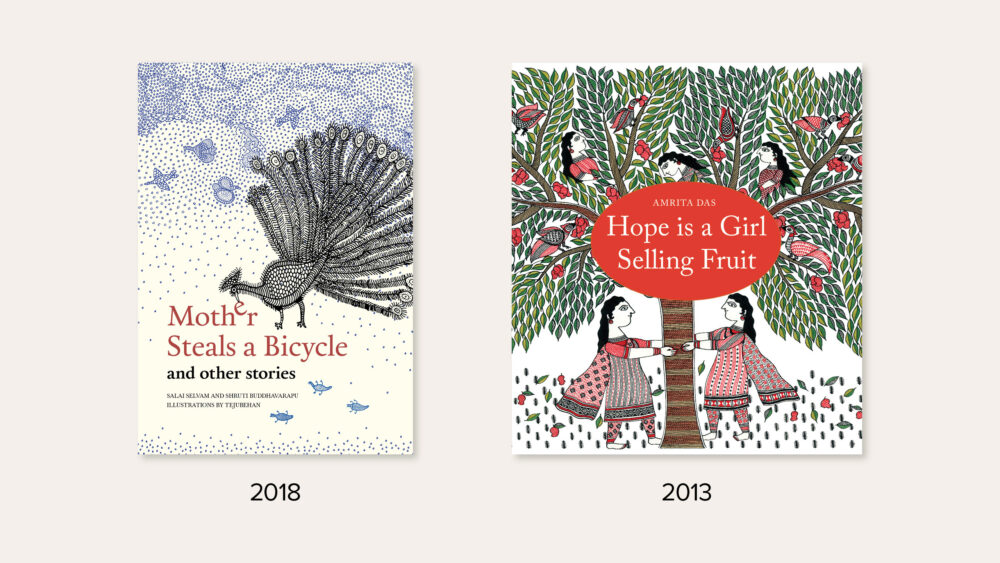
Mother Steals a Bicycle — Tales of a mother’s fun-filled and adventurous childhood
Hope is a Girl Selling Fruit — A coming of age story of a girl who loves to draw
Our commitment to exploring women’s lives and experiences — with all their strengths, contradictions and longings — has taken disparate and interesting paths. An interesting set of titles has to do with women’s creativity and art-making. More generally, an awareness of the way that gendered power structures work and shape women’s lives and art, informs our editorial thinking.
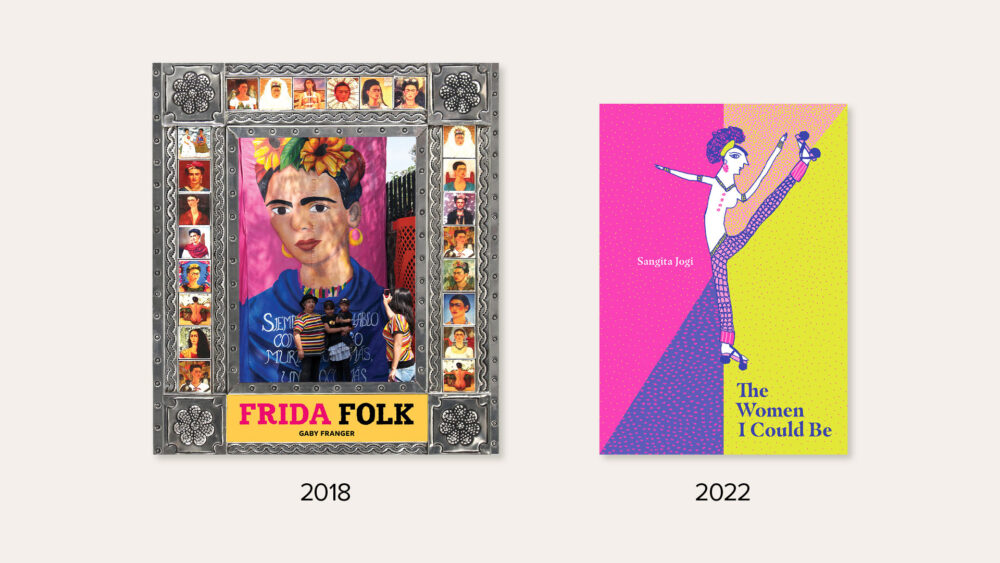
Frida Folk — A global tribute to the great Mexican artist by popular and folk artists
The Women I Could Be — Stunning portraits of feisty, self-assured women by a young working class woman artist
A Child’s Point of View
From the beginning, we’ve been interested in engaging with children’s sense — and understanding — of their contexts. An unusual early title, Landscapes: Children’s Voices, featured children’s writing on their immediate environments. Based on the five landscapes described in ancient Tamil literature, these narratives, from an embedded, engaged point of view, offered a contrast to standard social science teaching, which relies on top-down lecturing. We have, since, published books which offer a child’s perspective on complex social themes — and help communicate difficult experiences in a disarming way.
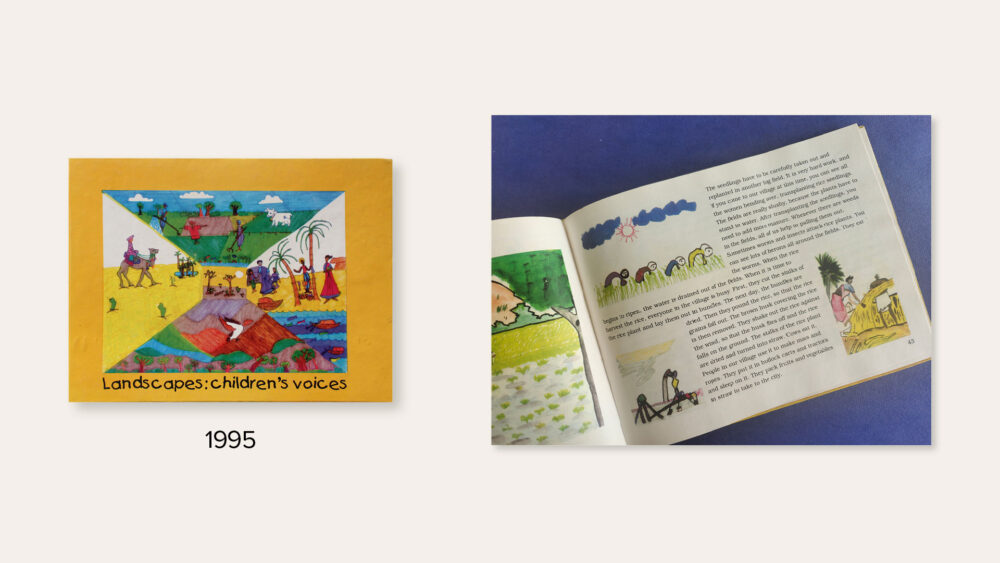
Landscapes: Children’s Voices
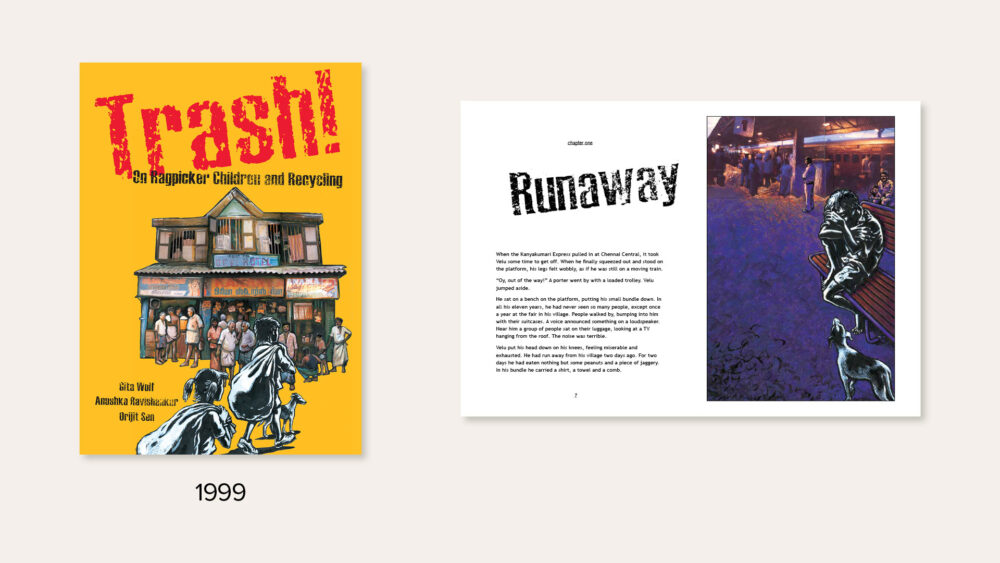
Trash! — A mixture of fiction and fact that draws on real-life narratives of ragpicker children
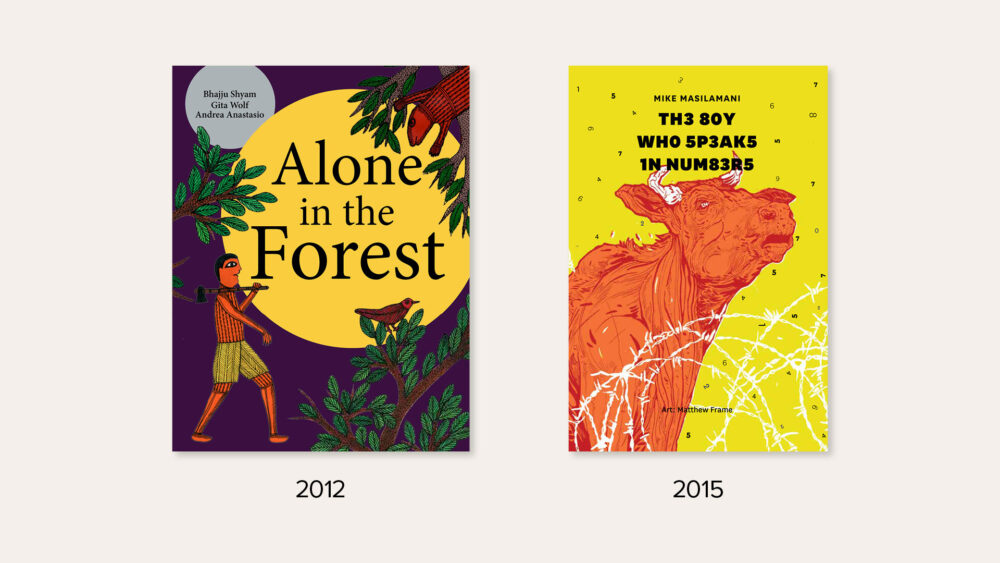
Alone in the Forest — A stunning picture book on the universal theme of fear, as experienced by a tribal child
The Boy Who Speaks in Numbers — A darkly satirical account of war, as seen through the eyes of a differently abled child
Alternative Narratives
A hallmark of our publishing vision has been to shift the point of view from which stories are told. Take, for example, A Wild Elephant at Camp: based on a real-life incident, this early title introduced children to the world of national parks and wildlife through the story of a child and his friendship with an elephant. All our titles to do with nature and the environment have focused on lived and empirical aspects, rather than theoretical arguments. We think they offer the reader a chance to identify with a unique perspective that emerges from living and labouring in a particular landscape.
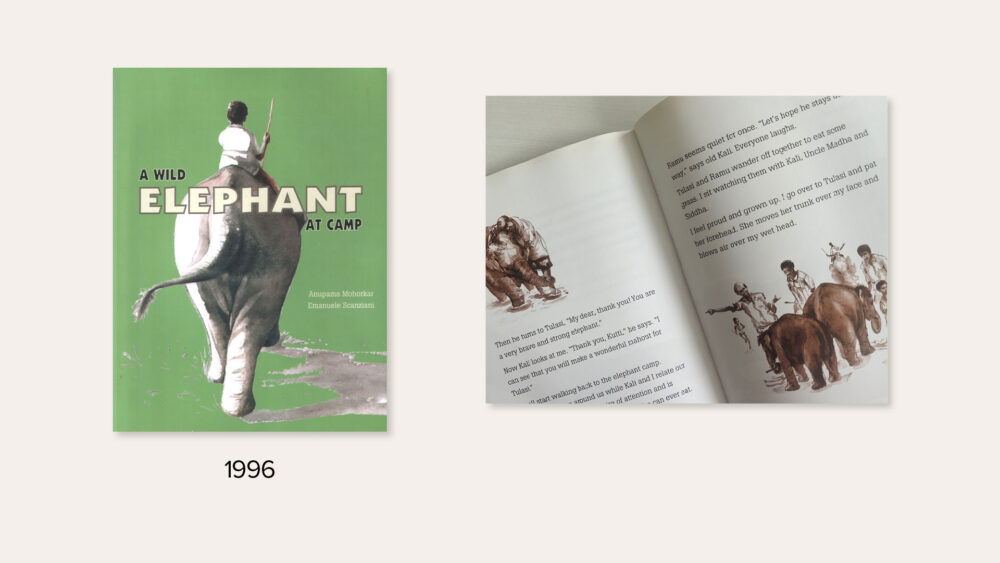
A Wild Elephant at Camp
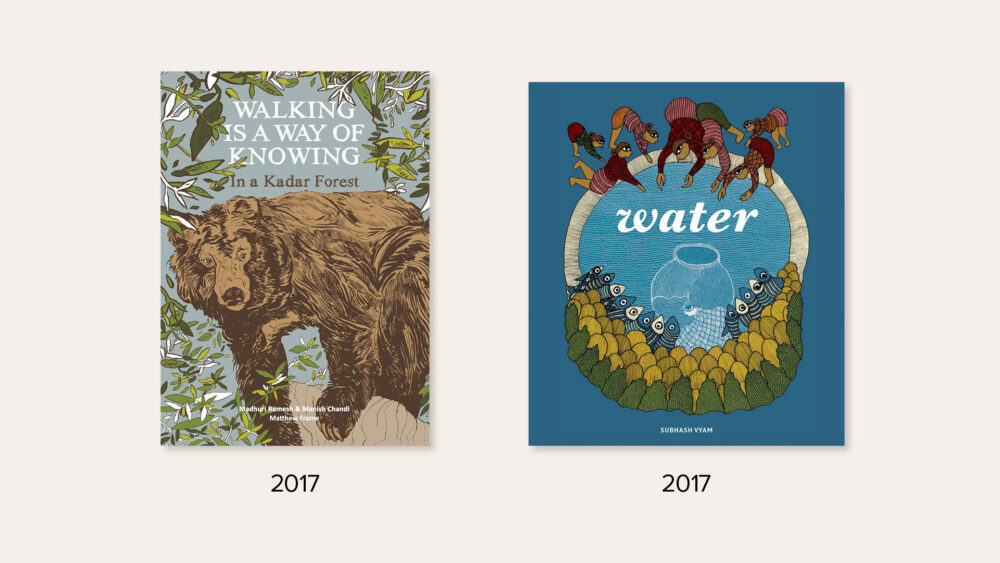
Walking is a Way of Knowing — An urban nature lover’s account of how an indigenous forest-dweller taught her to walk the tropical forest
Water — A richly illustrated Pardhan Gond tribal fable about water
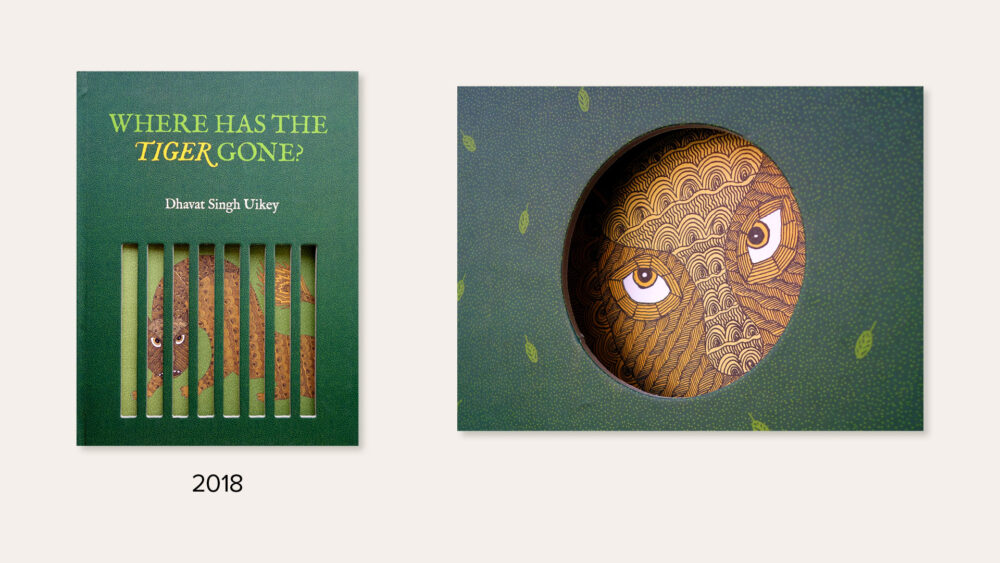
Where Has the Tiger Gone? — A retelling of traditional Pardhan Gond tales about the tiger-human relationship
Another way of engaging with the fact that there are multiple points of view is through re-interpreting familiar tales. We’ve tried several approaches — not only through retellings, but also adding further dimensions to the reading through art, design and argument.
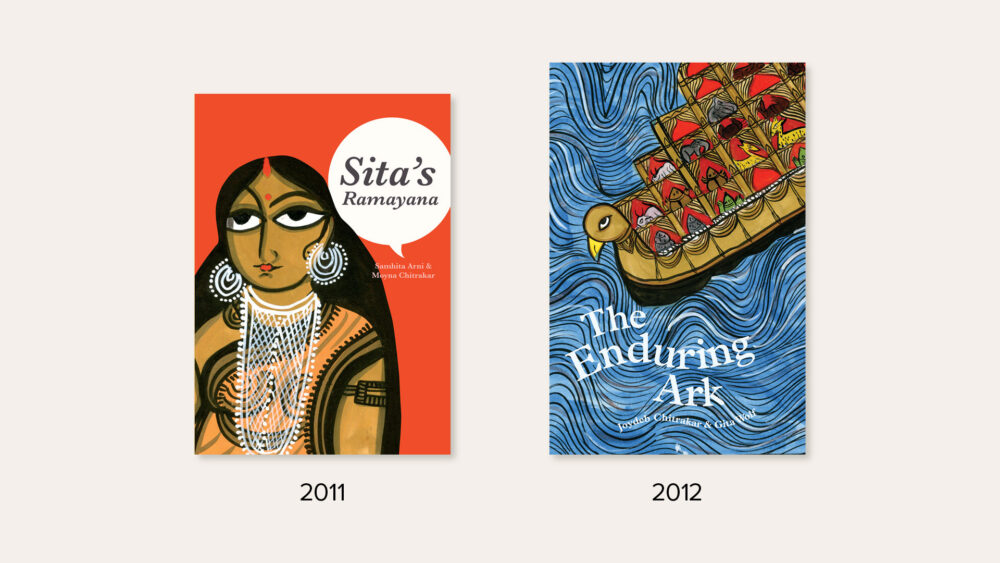
Sita’s Ramayana — A woman’s perspective on the fate of women in times of war
The Enduring Ark — A contemporary visual retelling of the great Biblical flood tale, by an Indian scroll artist
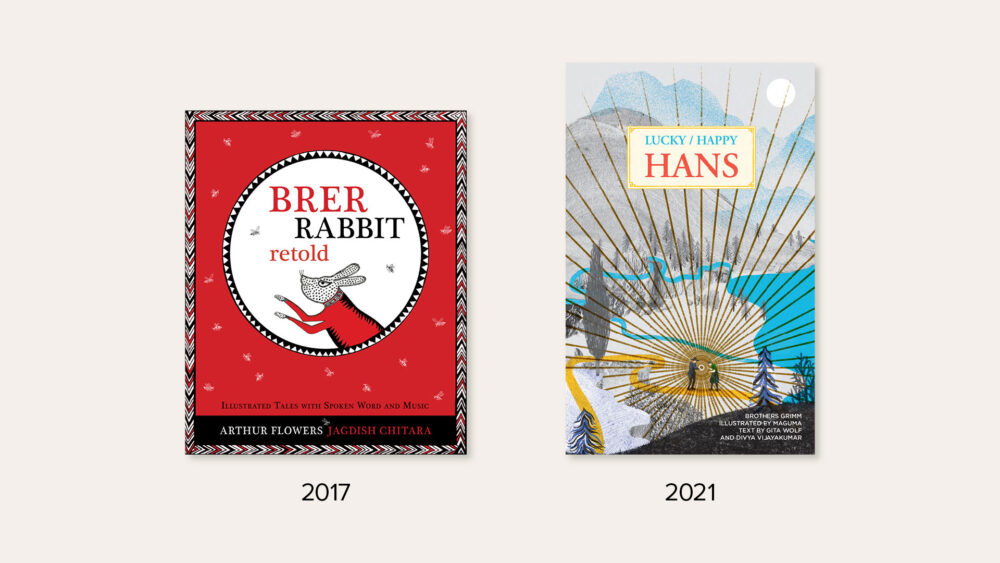
Brer Rabbit — A reclaiming of the Brer Rabbit stories by a contemporary African American griot
Lucky/Happy Hans — A whimsical take on a well-known tale from the Brothers Grimm
Art is Process
Our interest in art and art-making took another unexpected direction when we met Tarit Bhattacharjee, an art teacher at The School, Krishnamurti Foundation of India, Chennai. His teaching methods were marvellously open-ended — art was never about a perfect product, but a creative process that embraced accidents and ‘mistakes’ that invariably happen along the way. To children who are dismayed when their drawings don’t turn out the way they intend, this has been an enabling approach.
Child Art with Everyday Materials was the book we evolved with him, and in keeping with his unorthodox methods, we produced it unconventionally, with coloured images tipped onto kraft paper and spiral-bound pages. This was our first foray into experimental production, with the form reflecting the ‘craft’ aspect of the content. We went on to publish a series of books on art and craft pedagogy over the next decade, called ‘Craft Without Limits’.
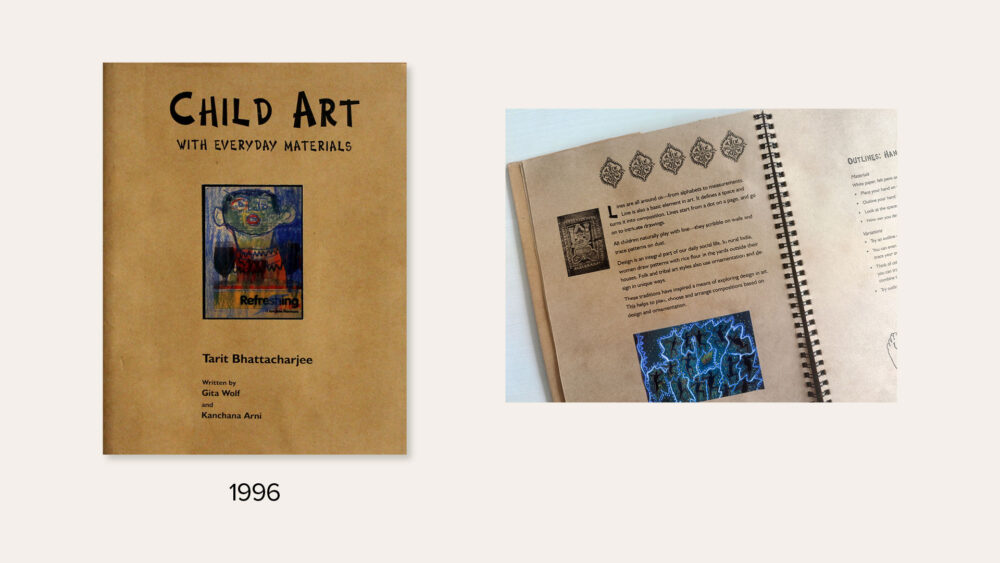
Child Art with Everyday Materials
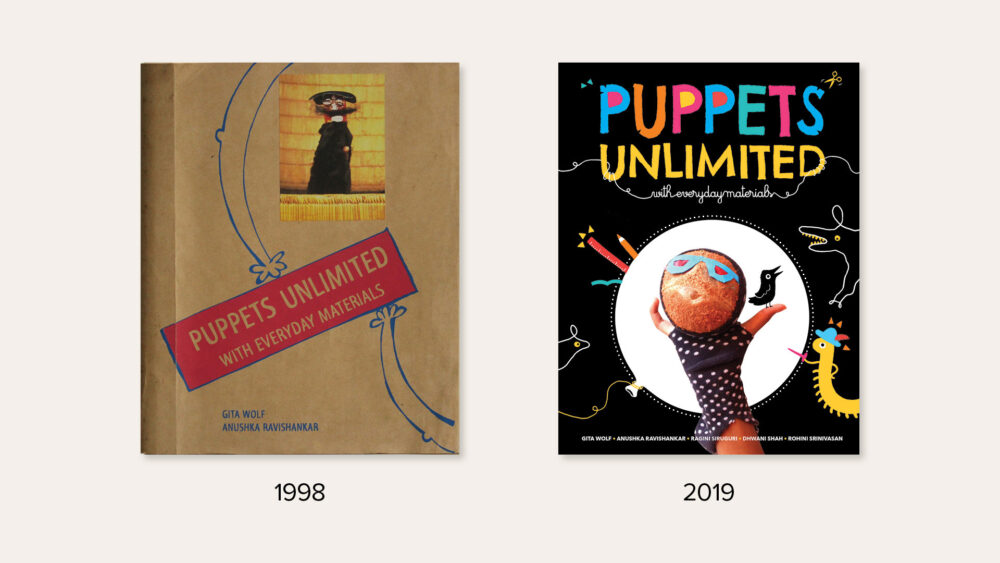
Puppets Unlimited — Two different editions of a zany how-to book that shows how anything can become a puppet
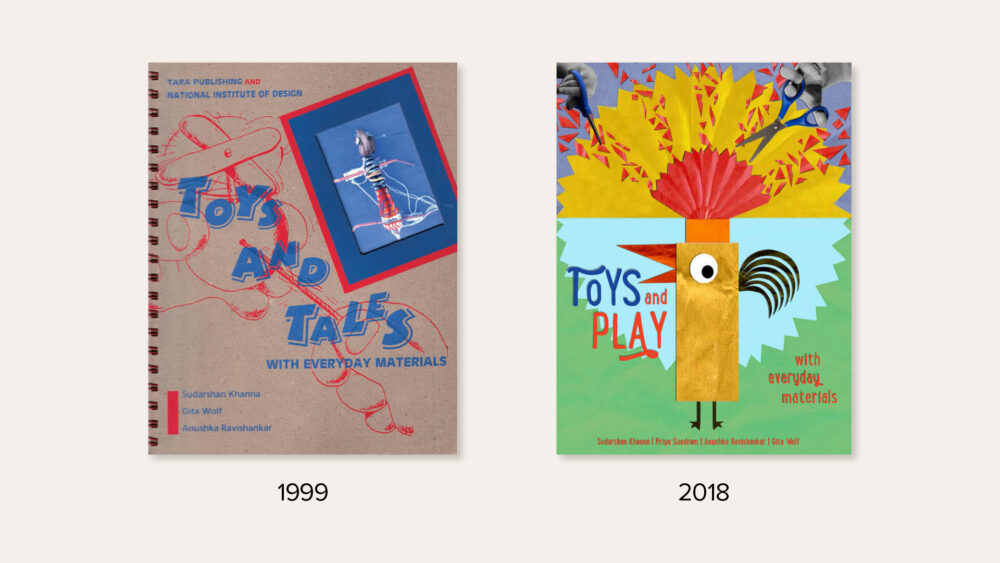
Toys and Tales to Toys and Play — An all ages craft book on toy-making; an updated version for the digital age
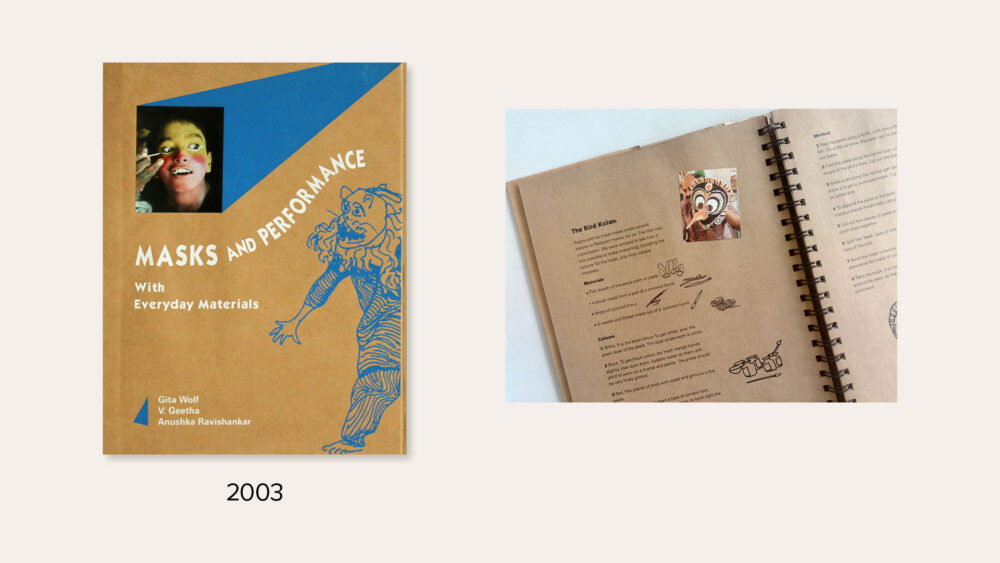
Masks and Performance — One of a kind book on making masks and designing a masked performance
Art pedagogy remains a staple of our publishing — and the other titles we added to our list over the years all have this open and flexible approach to fostering creativity.
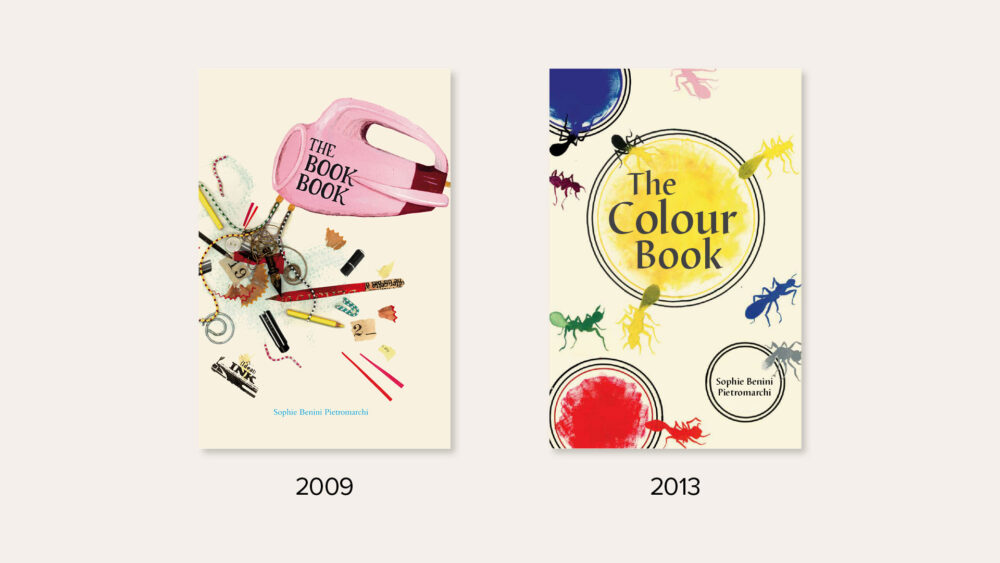
The Book Book — A whimsical hands-on guide to book-making, from the writing to the finished product. The Colour Book — A poetic and practical guide to colour, its many contexts, occurrences and uses
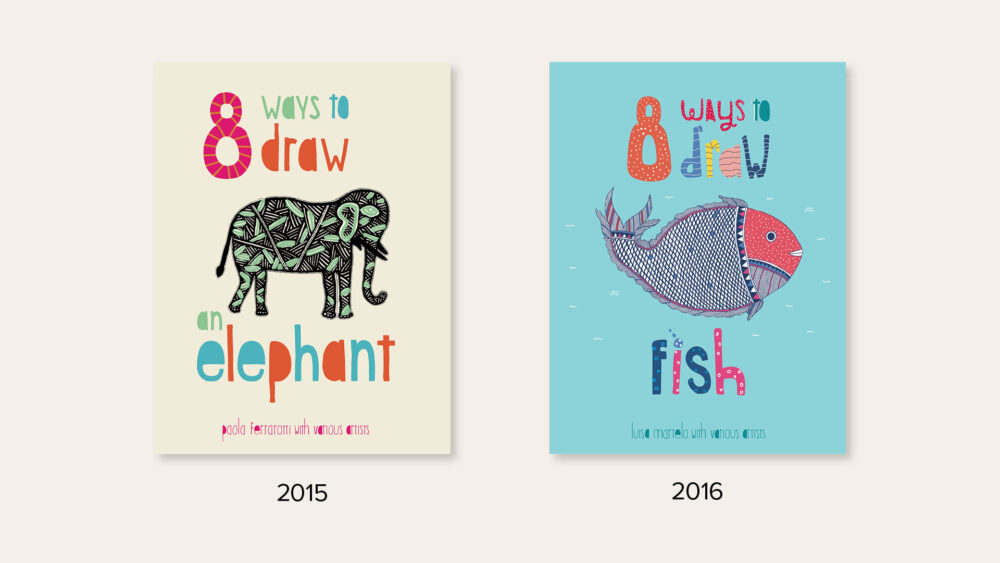
8 Ways to Draw an Elephant, 8 Ways to Draw Fish — Activity books introducing Indian art traditions
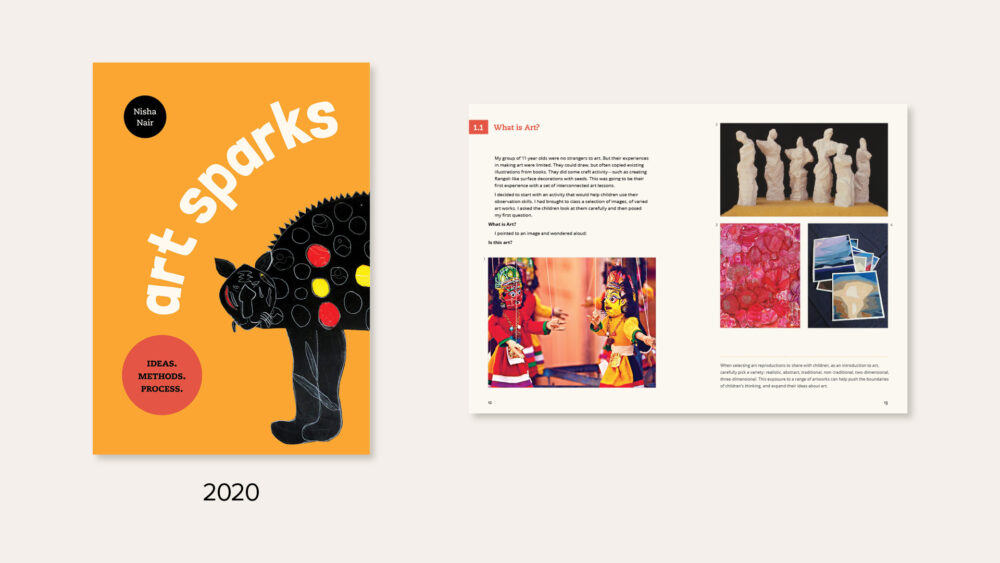
Art Sparks — A book on art, the art process, designed for the art teacher and classroom
The Larger Picture
In 1995, the second year of our publishing, we collaborated with The School, KFI on another book project. Called Mylapore: An Area Study, it was based on student work, to do with a particular neighbourhood in Chennai. Through walking, observing and interviewing people, children had learned of the many aspects that go to make a locality and a community — people, landmarks, trade, transport places of worship… It was a modest book, but its central tenets spoke to us. It had to do with establishing contexts for — as well as connections between — different aspects of a place and people. This is the approach we favour in all the location-specific projects we have published since that time.
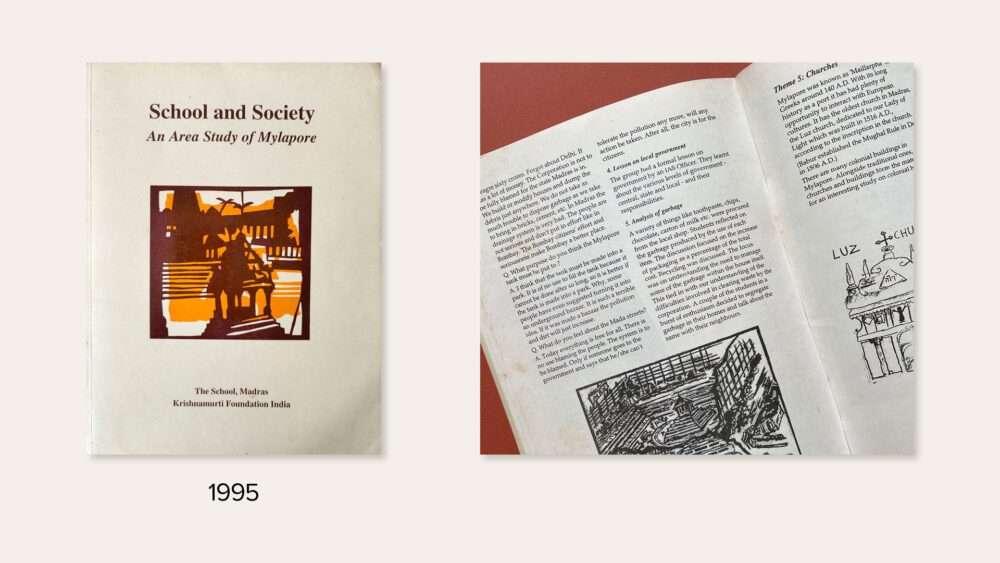
Mylapore: An Area Study
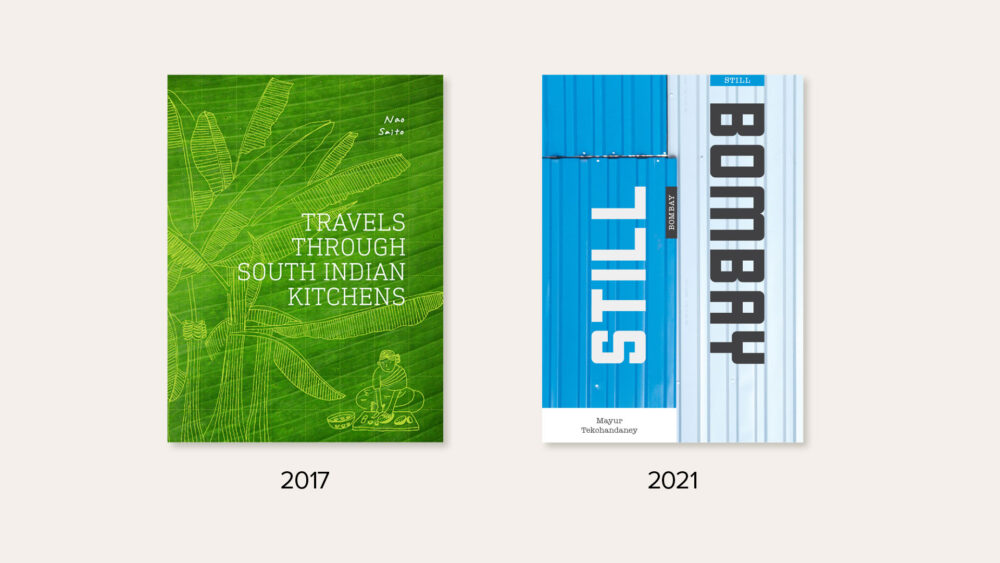
Travels Through South Indian Kitchens — An unusual travelogue that brings together recipes, architecture and musings on space.
Still Bombay — The great metropolis brought alive by street and architecture photographs and the personal essay
At times this approach can take the form of framing and contextualising content for our readers. Depending on the theme, we’ve done this in several ways: In the case of popular art, for example, we have linked artists’ views of their work with the many contexts that anchored their lives and labour; the economics that underlies their work, the social worlds that lend it meaning, and the unselfconscious aesthetics that shapes it. Setting such work within a context guards against it being appropriated in unintended ways.
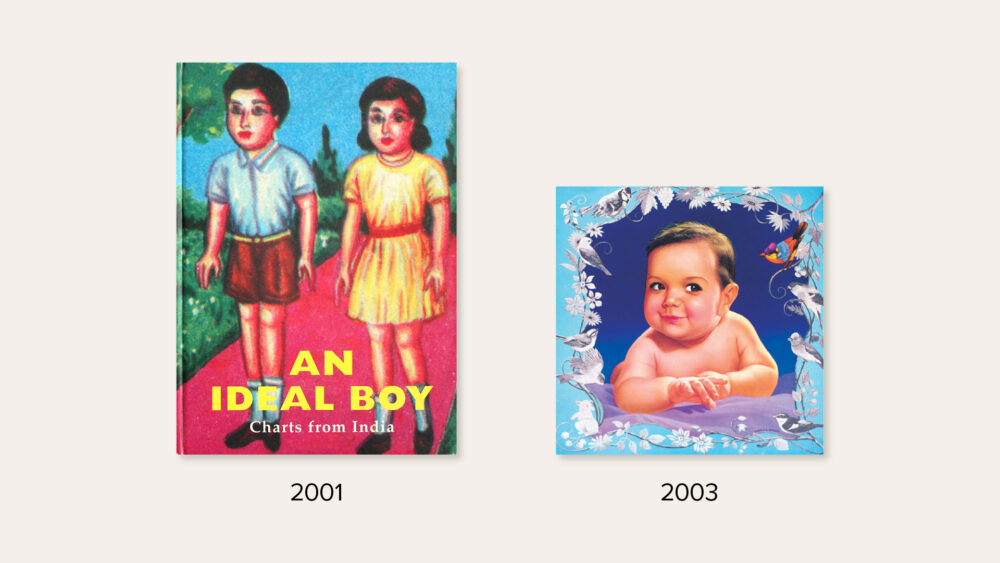
An Ideal Boy — A collection of widely used educational charts, with notes on their history, the art they feature and their making.
Baby! — A compilation of vintage baby posters from the golden age of popular art
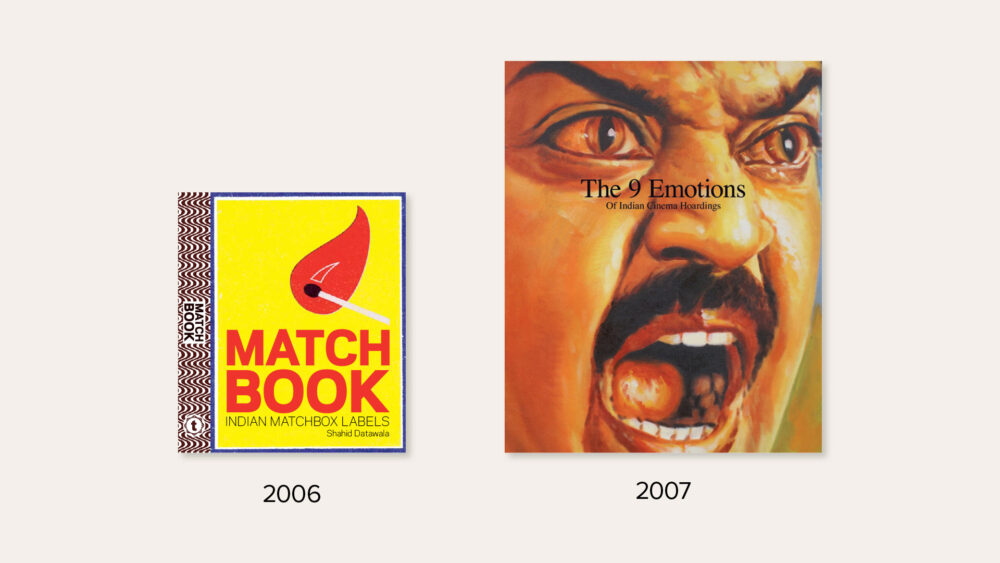
Matchbook — An anthology of Indian matchbox labels… with a critical essay on the labour and conditions of their making.
The Nine Emotions of Indian Cinema Hoardings — A visual tribute to the vanished art of South Indian cinema billboards
In some cases, we have brought in ‘the larger picture’ to point to how art traditions emerged out of lived life. Landscape, labour, rituals, beliefs — and more generally historical changes — singly and together, play a role in shaping the artist’s imagination.
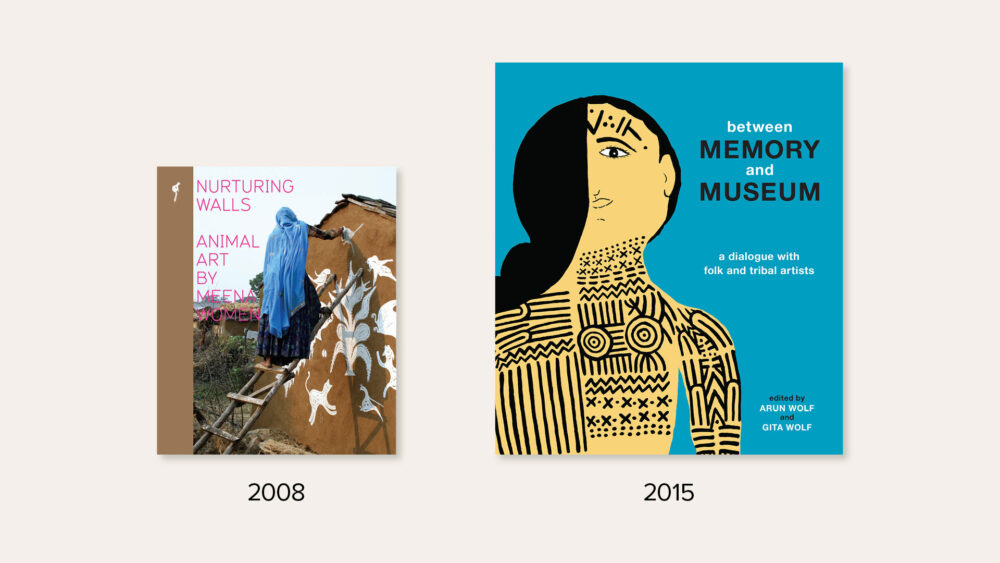
Nurturing Walls — A rich visual and verbal tribute to a distinctive female art form.
Between Memory and Museum — 38 extraordinary folk and tribal artists from India reflect on the museum as an institution.
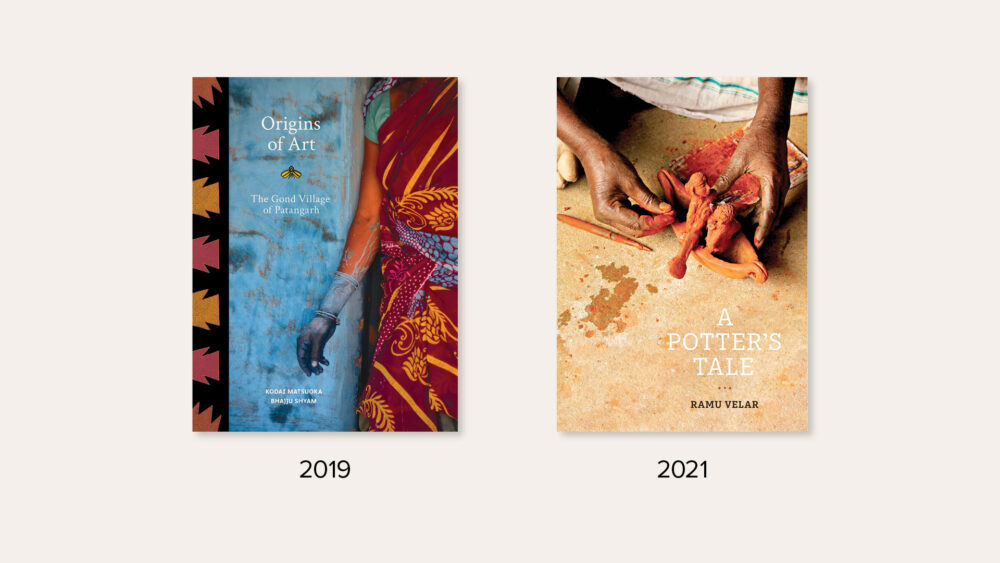
Origins of Art — Art and conversation that explore the vital connections between lived life and the practice of art.
A Potter’s Tale — Reflections of a life in pottery, narrated through text, photography and art
Nothing is Impossible
A key title from the early years was The Very Hungry Lion. It is only with hindsight that we realised how crucial this book has been to many aspects of our publishing. The project was merely an idea when Gita took it to our very first Frankfurt Book Fair — a folk tale she had re-written, and which Indrapramit Roy, a contemporary artist, had illustrated in the Warli tribal style of painting. The book was not done, and Gita had taken a few sample pages, to show to possible publishing partners at the fair. At the time, Chennai did not have digital colour printing facilities, and so we asked a young screen-printer we knew, C. Arumugam, to print these pages on handmade paper.
As luck would have it, the only person with whom we had an official appointment at the fair, Anne Millyard of Annick Press in Canada, fell in love with the project at first sight, and ordered 8000 copies of the book, on the spot. She only asked us one thing: to screen-print the entire book on handmade paper, just like in the sample sheets.
“I was elated, as you can imagine!” Gita said later, “and it was only when the escalator landed me on the ground floor, did the thought strike me… but how? How were we going to make 8000 copies?” “No problem!” said Arumugam, back in Chennai. “Nothing is impossible.”
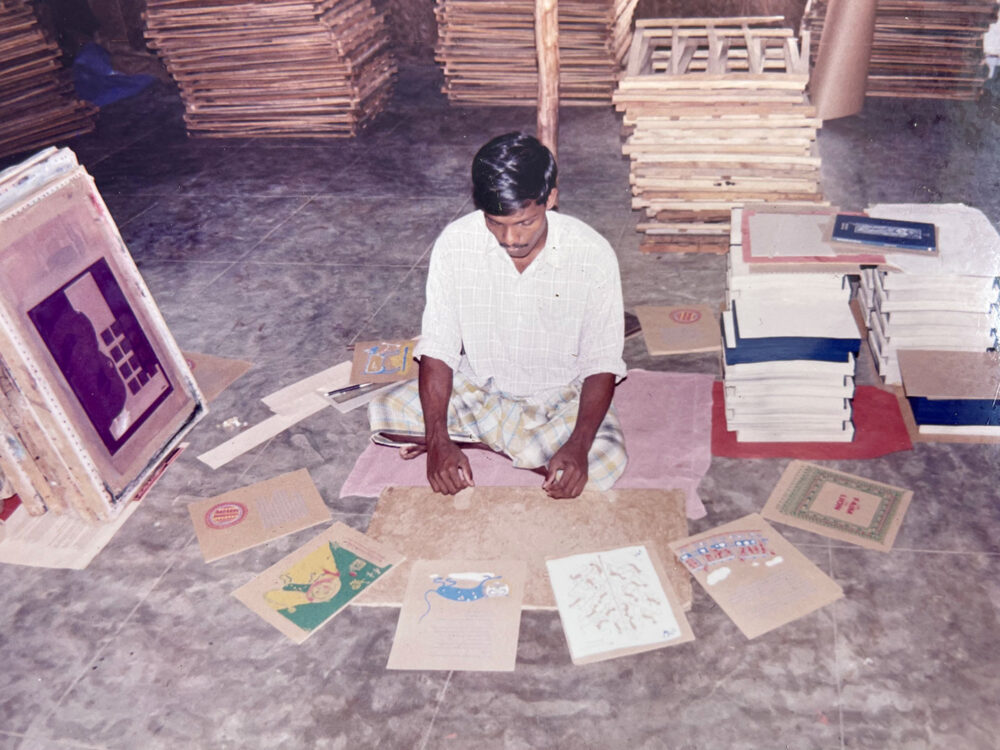
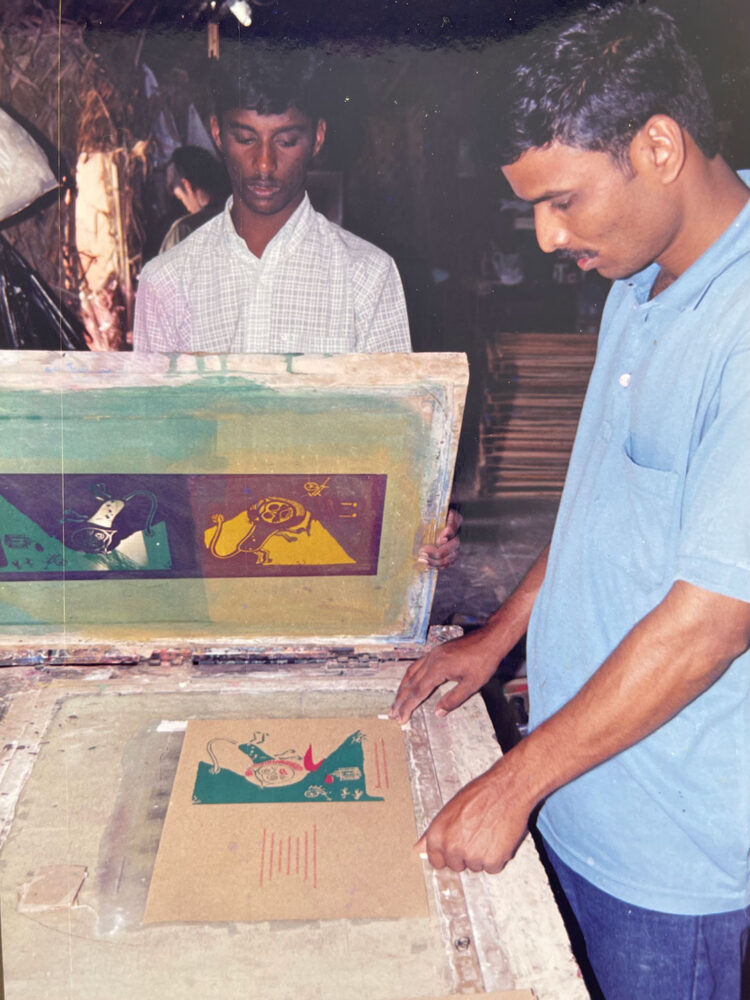
Making The Very Hungry Lion
The rest, as they say, is history. Annick Press paid an advance that gave us start capital, and Arumugam set up the legendary screen-printing unit that has become such an iconic symbol for Tara. Our handmade books meanwhile have become well known all over the world, a source of both pride and a steady income for us. The whole enterprise has been built on certain premises: firstly, of course, that we’re up for taking on any challenge, and have managed to make what appeared daunting, possible. Secondly, the importance of local resources — we train people looking for a vocation into book artisans. Thirdly, the unit is run on egalitarian and cooperative principles, and our printers reach an unimaginable level of perfection through a shared commitment to the end product. And finally, our handmade books tread a fine balance between art, labour and value — they are in fact artisanal limited editions, but we have managed to scale the production such that the printers are paid fairly, yet able to produce enough numbers to make these fine books accessible to more people.
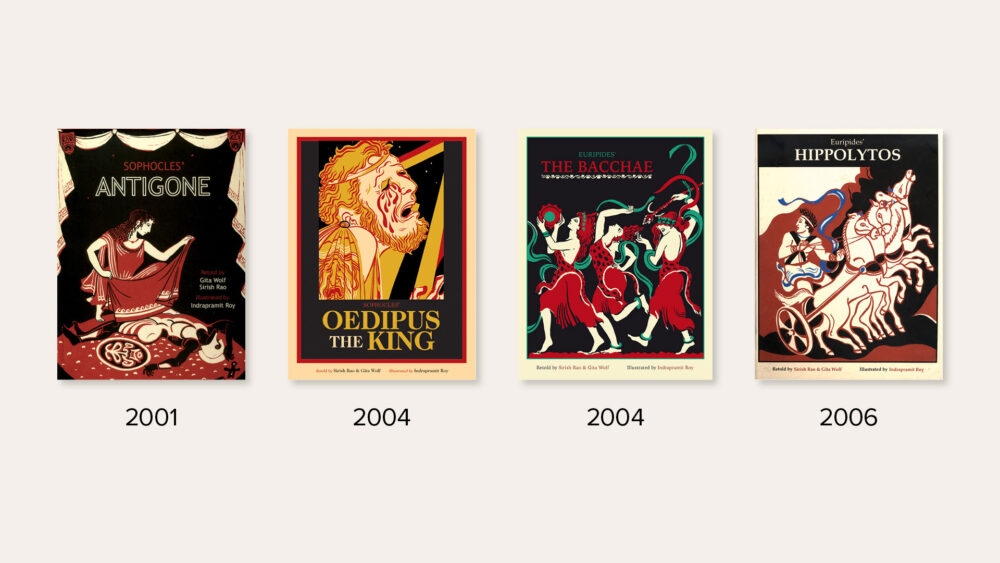
Antigone, Oedipus the King, The Bacchae, Hippolytos — Silkscreen-printed and sumptuously illustrated versions of classical tales from ancient Greece
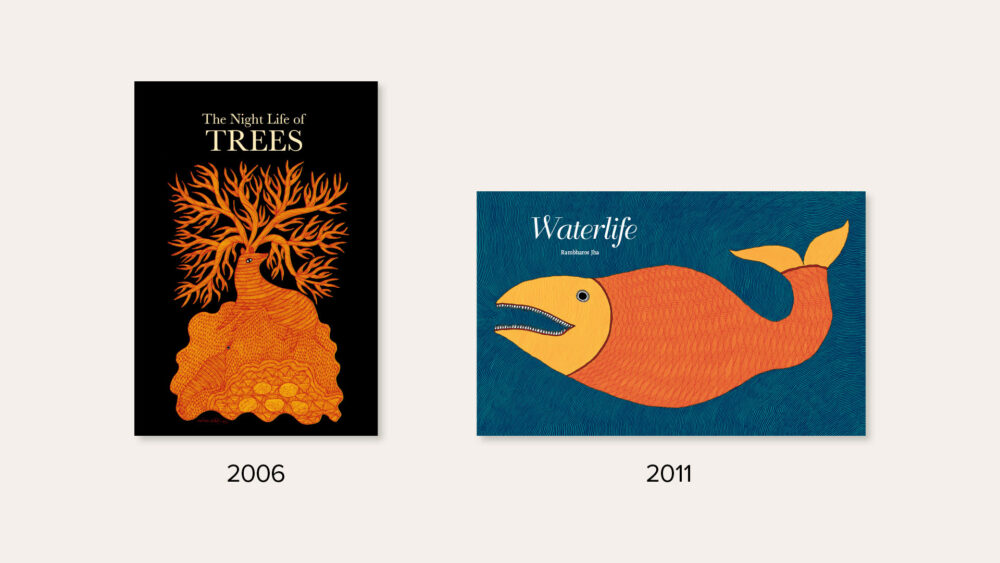
The Night Life of Trees — A handmade classic featuring Pardhan Gond art and folklore to do with trees;
Waterlife — Exquisitely printed images of an imaginative water-world from the Mithila folk tradition.
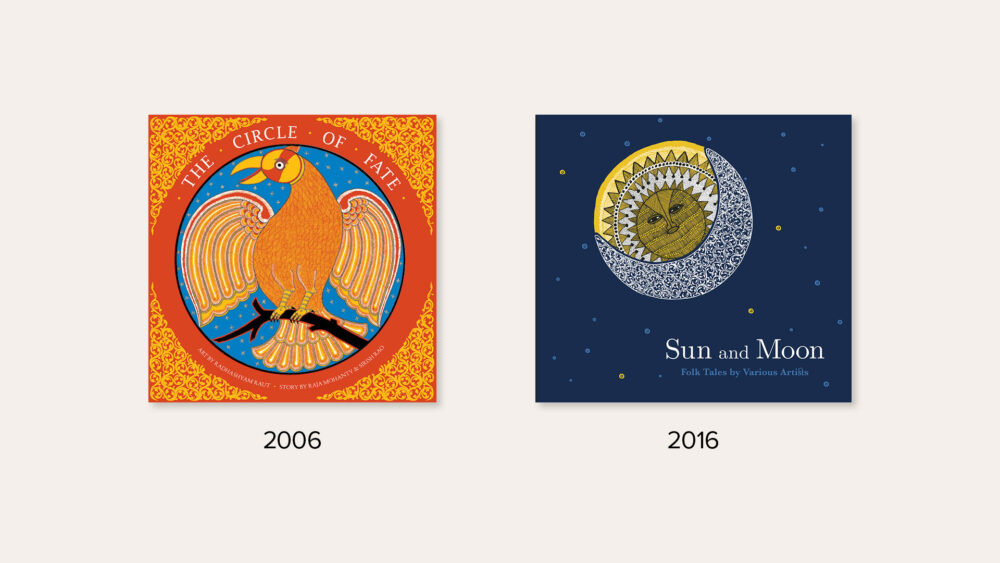
The Circle of Fate — A silkscreen printed fable of destiny and love, in the Patachitra temple painting style.
Sun & Moon — A silkscreened anthology of art and stories on the sun and moon, from some of India’s finest living indigenous artists.
Over time, with our handmade book experience, we’ve come to realise that production is not a mechanical process. A method of production creates particular meanings in the product. And this is perhaps why the printing process remains a source of wonder to us: in addition to silk-screen printing, we use the regular offset process, but have also bought a letter-press and are experimenting with risograph printing.
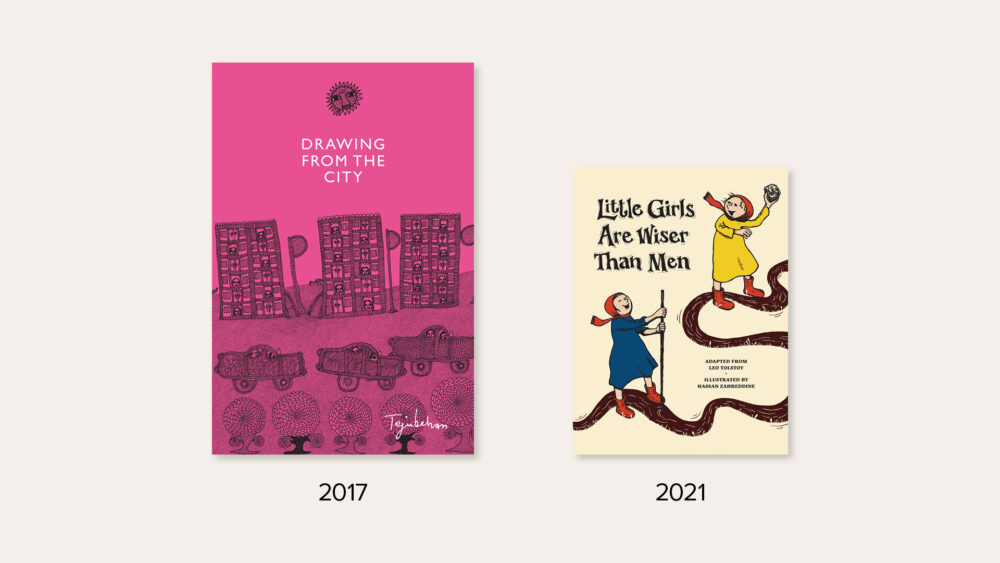
Drawing from the City — An artist’s tale, rendered in line art and enhanced by risography.
Little Girls are Wiser than Men — A letterpressed edition of a Tolstoy classic, with special engraved art
Production has always been an adventurous aspect of our enterprise. With our years of experience, we’ve become much more confident as we go along — to take on not only different kinds of printing, binding and die-cuts, but also to innovate across domains, combining materials and methods.
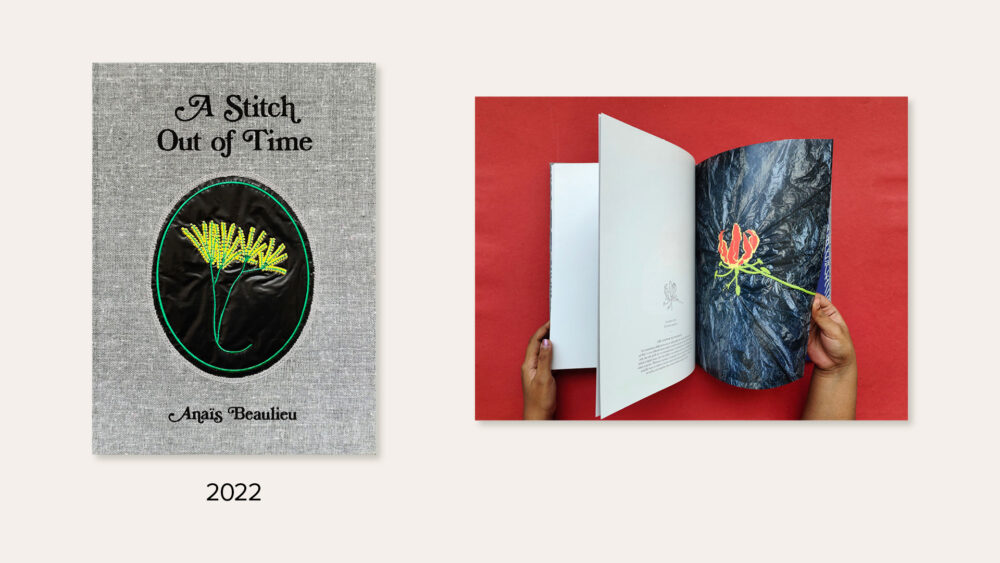
A Stitch Out of Time — A book that combines textile art, silkscreen printing and cloth-binding
Who Tells the Story?
The Very Hungry Lion also started us off on another journey, but this time more in the direction of what could be called negative education. The book was illustrated in the Warli art style — admittedly extremely well — by a contemporary artist. As time went on, we thought about the fact that what was perhaps a style to a contemporary artist might well be something else for the indigenous artist from that tradition. We wanted to understand more, and the way to do this was to collaborate directly with them.
This quest turned out to be one of the richest and most meaningful undertakings in our publishing journey. We have since worked with an amazing variety of artistic traditions — each of them ‘picturing words’ in their own unique way. Through their particular frameworks of rendering and storytelling, these art practices cut through language barriers, and suggest new ways of seeing and knowing. Bringing them into the form of the book seemed important to us. For one, the book circulates more widely than a piece of art, making the art form more readily available. Secondly, a book intrinsically brings in a context, which has always been important for us. Thirdly, we found immense pleasure in working with brilliant traditional artists in a coeval space — bringing together our knowledge of book-making with their imagination and art making. Together, we came up with projects which were neither nostalgic nor exotic. We found this a truly radical undertaking.
Beasts of India (2003) was the first of our titles featuring indigenous art. We sent out a researcher to gather images of animals as they appeared in different indigenous art traditions, and to find artists willing to work with us. Since that time, our collaborations with these artists have continued through workshops, visits and exchanges. We meet on the common ground that tradition is a respectful attitude to the past, and that it is constantly evolving into new forms without losing touch with the old.
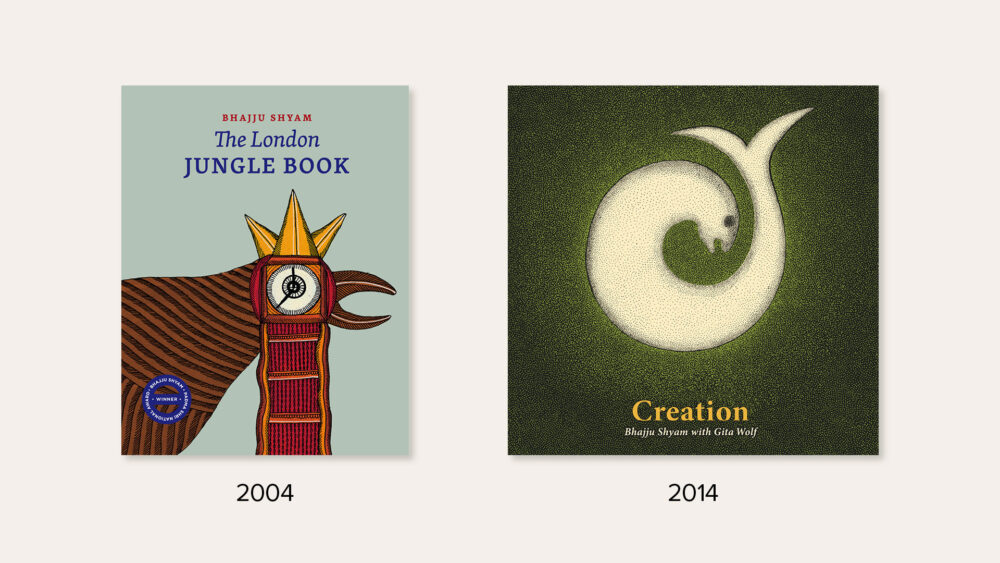
The London Jungle Book — Visual travelogue from a Pardhan Gond artist that reverses the anthropological gaze.
Creation — Richly illustrated stories of origins, transformations and ending, from the Pardhan Gond community.
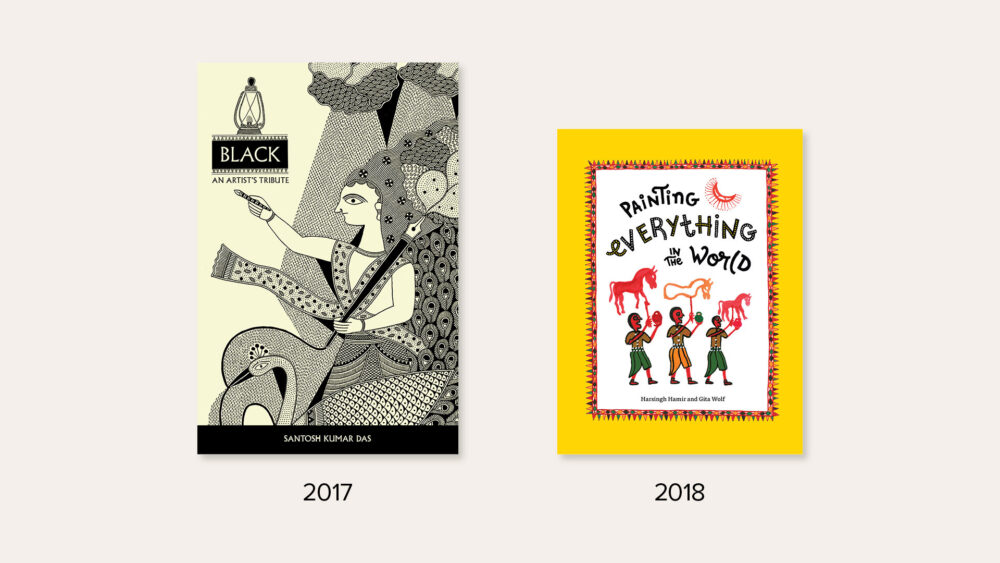
Black — A poetic and painterly memoir by a master Mithila painter
Painting Everything in the World — A children’s tale from the Rathwa tradition, which points to the transformative power of art
Risks and Rewards
In 1996, we were introduced to nine year old Samhita Arni. Her mother, Kanchana Arni, told us that her daughter had been drawing and writing The Mahabharata since the age of 6. Kanchana had carefully collected bits and pieces done on the back of envelopes, old notebooks and scrap paper, and was putting them together. Not sure where this would lead, we asked to see it… and were completely bowled over. It was the most astonishing rendering of the epic tale we had ever encountered.
We joined in the painstaking reconstruction of the epic that Kanchana had started, and The Mahabharata: A Child’s View was born. It went on to become a huge international success, with the great Italian writer and mythographer, Roberto Calasso offering to publish an Italian edition of the book. He also literally took on the role of an agent, advocating for it widely amongst fellow publishers, worldwide. Eventually the book was published in several European languages.
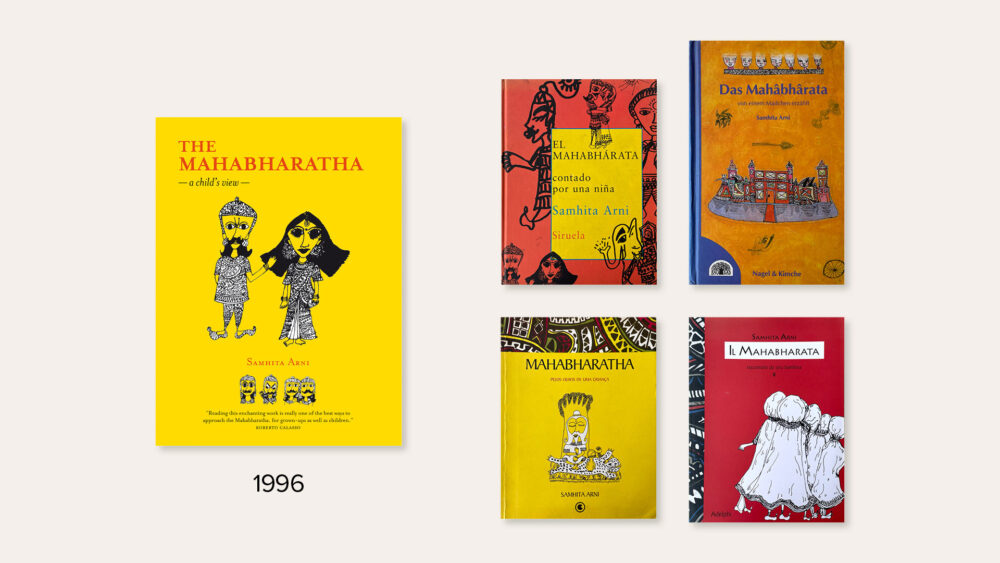
The Mahabharata: A Child’s View — A vividly illustrated one-of-a-kind retelling of the great Indian epic by a pre-teen.
Such serendipity in publishing is not unusual. But not every serendipitous encounter has had the trajectory of this book, it can be hit or miss, but we enjoy taking such risks, especially when our ‘publisher’s instinct’ urges us to give it a try. Whatever the commercial outcome, crossing paths with creative people, and coming up with projects we think are valuable, is a reward in itself. Some very interesting (and unclassifiable) projects have come about over the years, and we’ve grown in directions we never imagined possible.
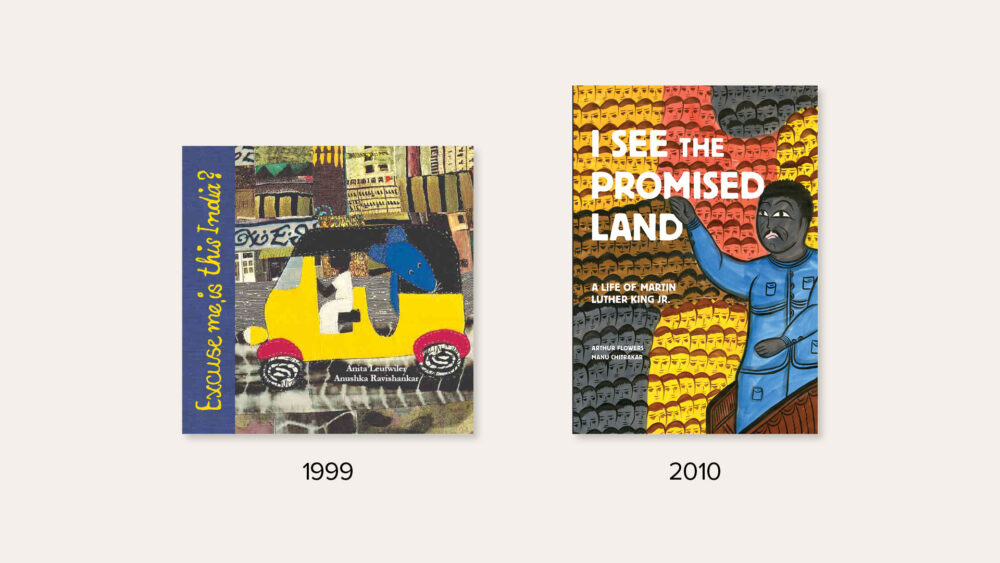
Excuse Me, Is This India? — A Swiss-German quilt artist’s impressions of India and Indian textiles.
I See the Promised Land — An African American griot and an Indian scroll painter’s vision of the life of Martin Luther King Jr.
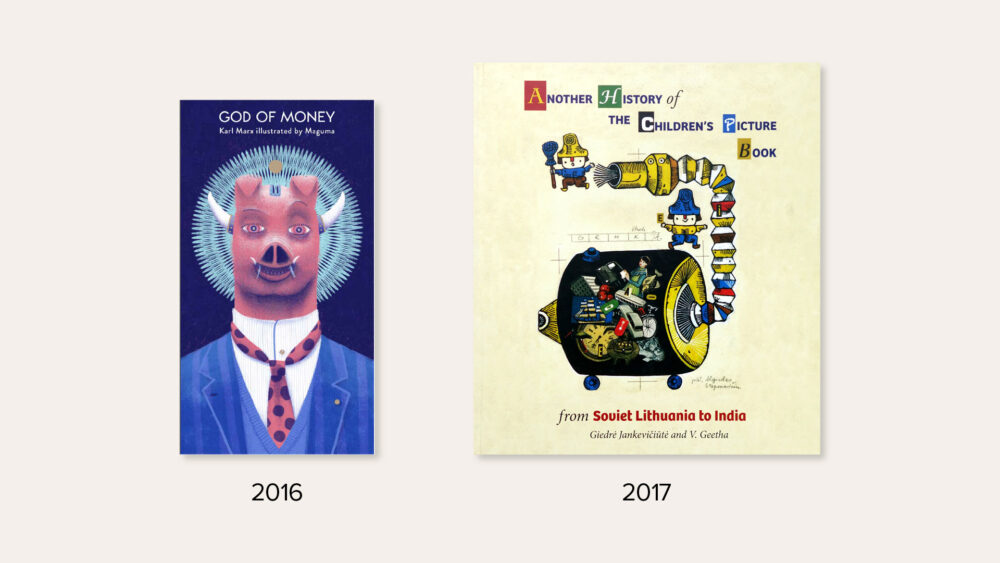
God of Money — A contemporary Spanish artist’s interpretation of Karl Marx’s celebrated critique of the mind-numbing power of money
Another History of the Children’s Picturebook — A re-imagining of global picture book history, centred around the Soviet Union’s publishing experiments.
Laughter
In 1997, we were joined by a writer who gave concrete form to our partiality for jokiness: Anushka Ravishankar. She took nonsense and comic verse very seriously, and her very first book, Tiger on a Tree, remains a children’s classic to this day. The late Pulak Biswas, one of India’s finest illustrators, had come up with a visual story about a tiger cub who strays into a village, only to be captured and let off by the villagers. Anushka wrote a text to the images, reversing the sequence of the words to a story usually coming first. Her terse comic verse took the tale to a new and delightfully absurd level, bringing in an element of wit and whimsy which was unmatched. It still remains a personal favourite, one of the few books where we wouldn’t want to change a thing — image, text or design — in edition after edition. Anushka has since gone on to write over 25 books for Tara. They, along with the other jolly books we’ve published, are part of a repertoire we all quote from and chuckle over, from time to time.
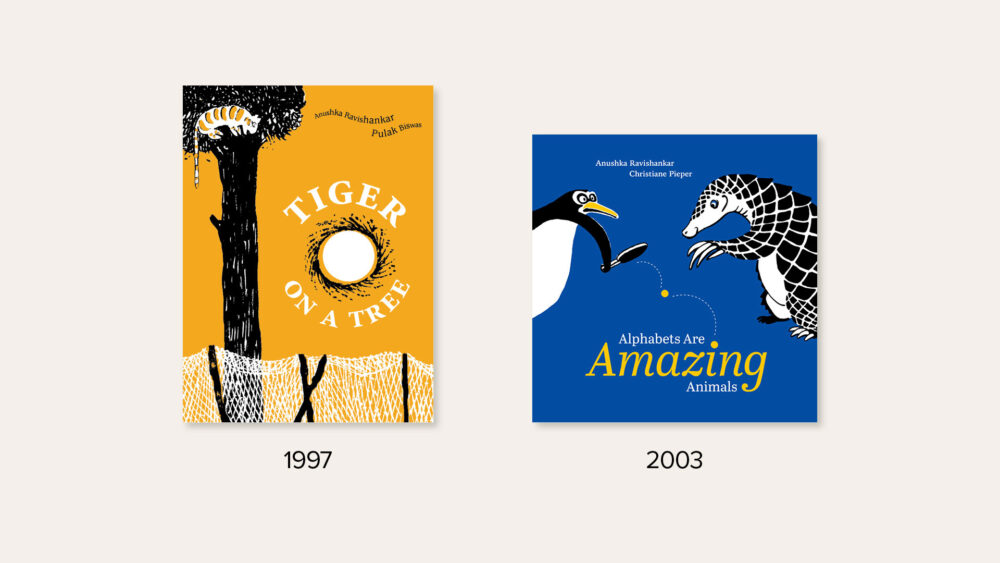
Tiger on a Tree, Alphabets are Amazing Animals— A book of alliterative alphabets and all kinds of animals
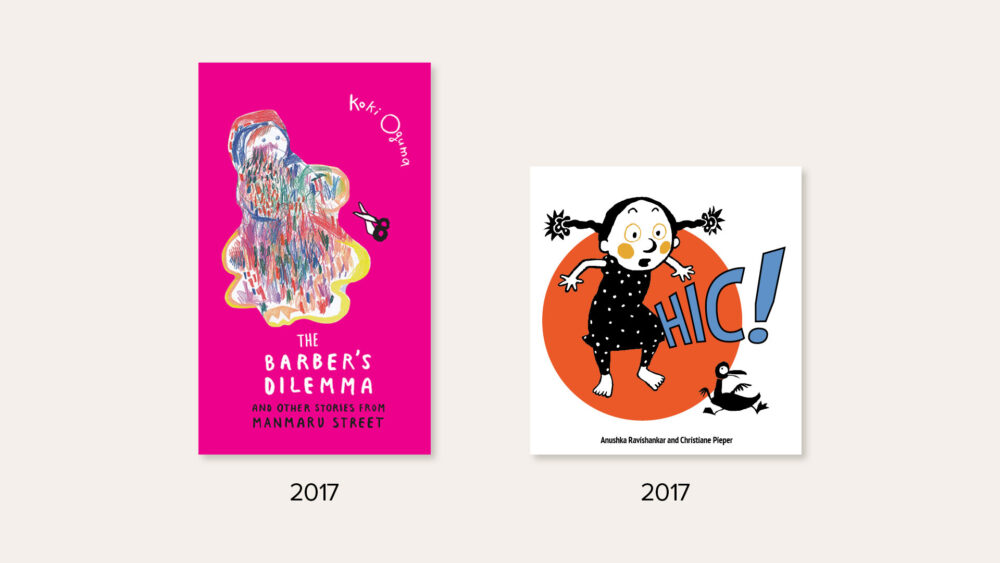
The Barber’s Dilemma — A Japanese artist’s quizzical and strange vision of his neighbourhood and neighbours.
Hic! — Absurd text and humorous art come together in this eccentric book on a cure for hiccups
Adventurous Forms
Another person who joined us to create Tiger On a Tree was designer Rathna Ramanathan. Like Anushka, she was instrumental in taking the book to another level, bringing in the colour orange judiciously into Pulak Biswas’ black and white illustrations, and setting the text to typeplay that ran and jumped with the tiger.
Design has become a vital part of our understanding of what made a book, and Rathna can be credited with coming up with a design language for Tara. She also introduced us to the amazing possibilities of form. An early experiment during this period was Hen-sparrow Turns Purple, a comic poem illustrated with jewel-like Indian miniature style paintings created by Pulak Biswas. Inspired by a piece of Thai stationery in the leporello form, Rathna created a long flowing format for the book, united by bands of screen-printed colour, with tipped-in illustrations. The book unfolded page by page into a long colourful scroll. A production nightmare, it was a risky proposition, but in the event turned out to be astonishingly successful.
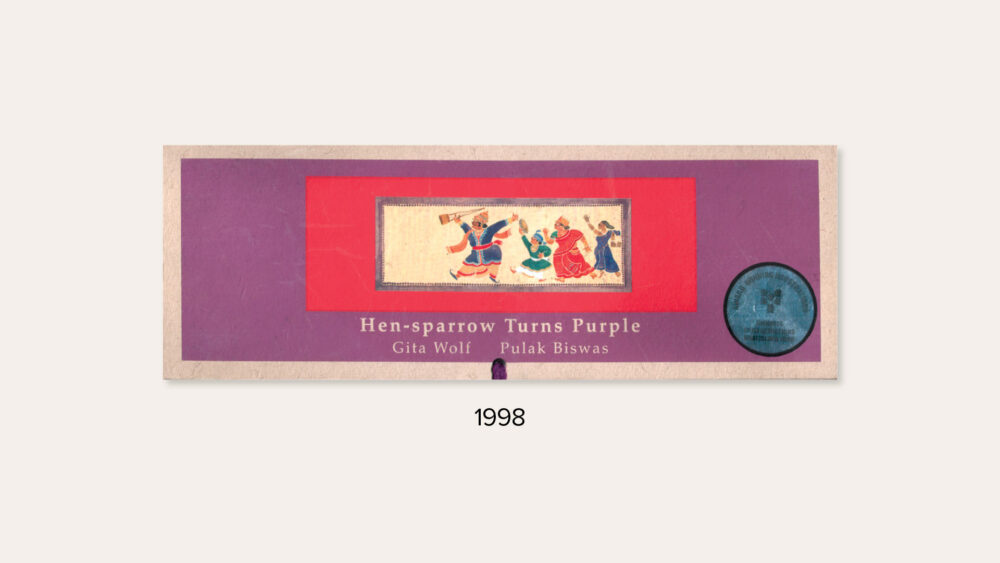
Hen-sparrow Turns Purple
Our adventures with form and material have continued and evolved over the years, from fold-outs to leporellos and pop-ups. Later experiments have included block-printed textiles, folded and wrapped into stitched books.
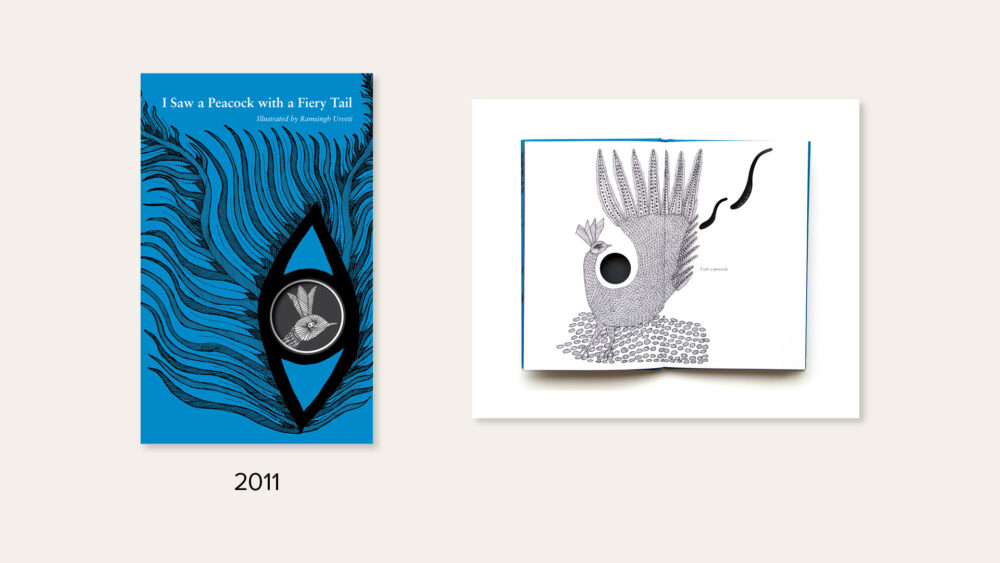
I Saw a Peacock with a Fiery Tail — A book whose design mirrors the shifting ways in which poetry creates meaning.
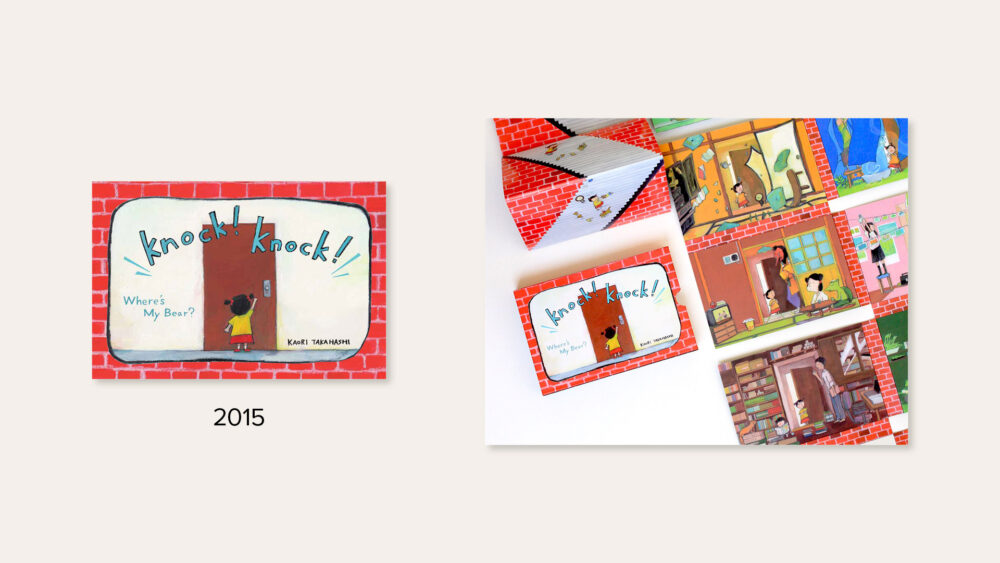
Knock! Knock! — A little girl’s search for her missing bear through cleverly designed book architecture
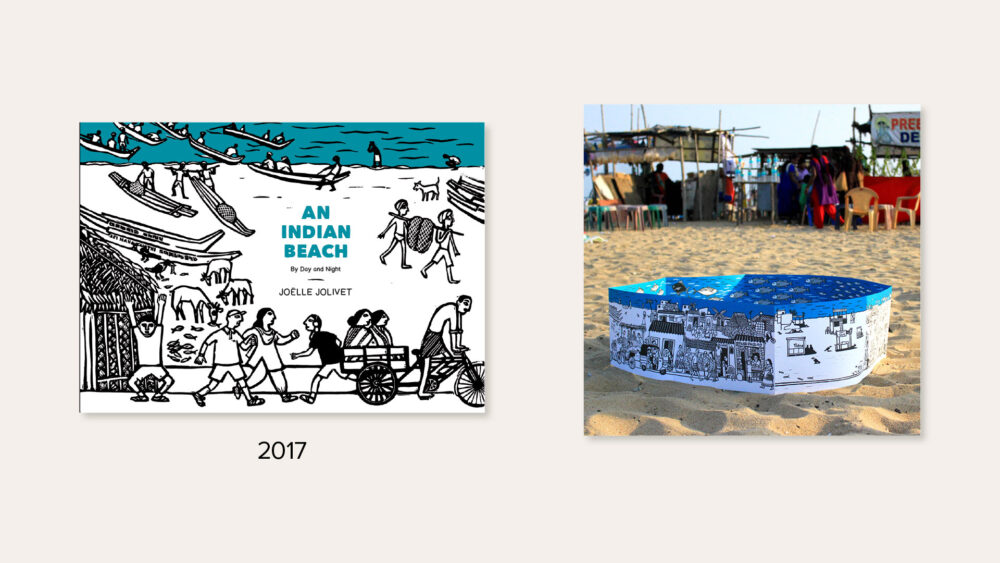
An Indian Beach — A never-ending circular book which explores life in an Indian beach
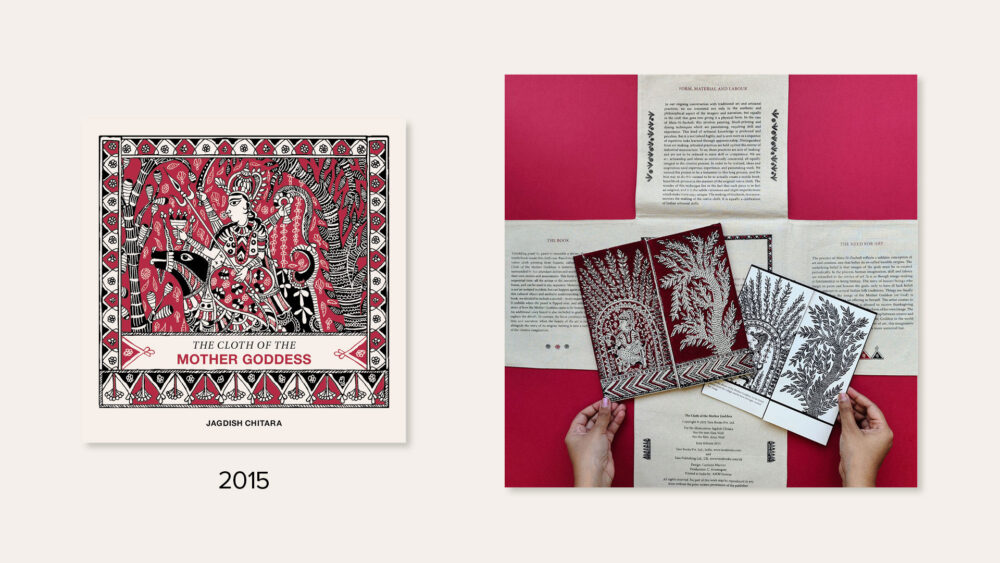
The Cloth of the Mother Goddess — Hand block-printed textile book that unfolds as a series of textile installations
Communication
A wonderfully strange project that Rathna Ramanathan and Anushka Ravishankar came up with in our early years sharpened our understanding of how we wanted our books to communicate. From the start, we were keen not to ‘dumb down’ the complexity of any content, but at the same time in making sure that it was not too opaque, academic or specialist for the lay reader. This was particularly the case with children’s books — there was no problem with the occasional hard word or complex image, but we wanted the reader to ‘get’ what the book set out to communicate.
In 1998, Anushka came up with a piece of nonsense verse called Anything But a Grabooberry, which Rathna illustrated through type play. Letters took the form of calligrams, image and text together becoming a kind of word puzzle that the child reader needed to decipher. The project set up delicious debates in house: about design, communication and how the book would be read and understood. We tested it with sets of children, and finally published the book. It did modestly well at the time, but we had a niggling feeling that this radical book had far more potential — we were missing something here.
And now, nearly 25 years later, we think we know what it is. There was too much going on, too many radical elements, each fascinating in its own right, but not quite adding up. So we looked at the book again, revised and edited the verse and reworked the type play elements, without taking away from the whole — and we were happy with how that has turned out. A forthcoming title, this new edition, called I Want to Be, is a testimony to our vision of combining experimentation with communication.
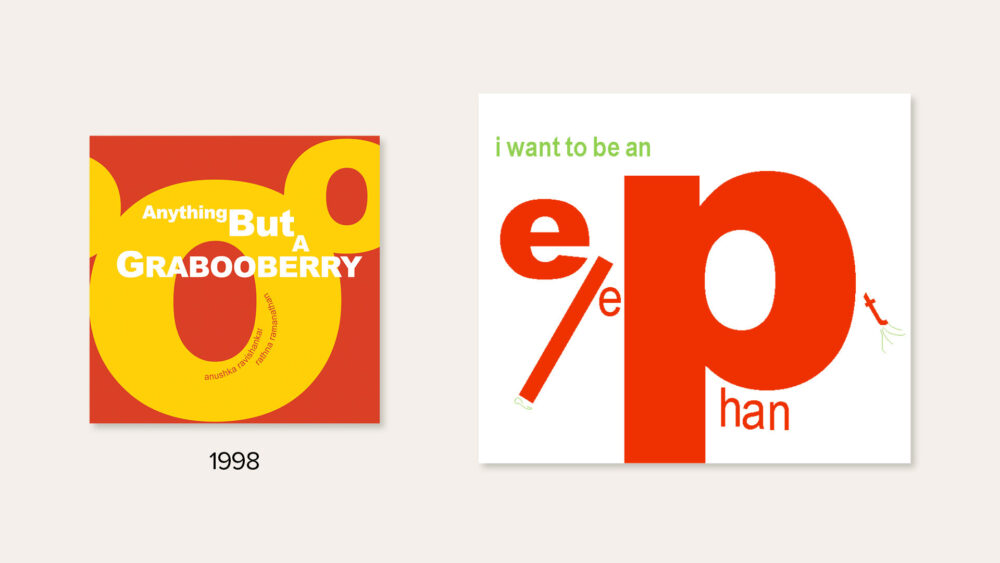
Anything But a Grabooberry
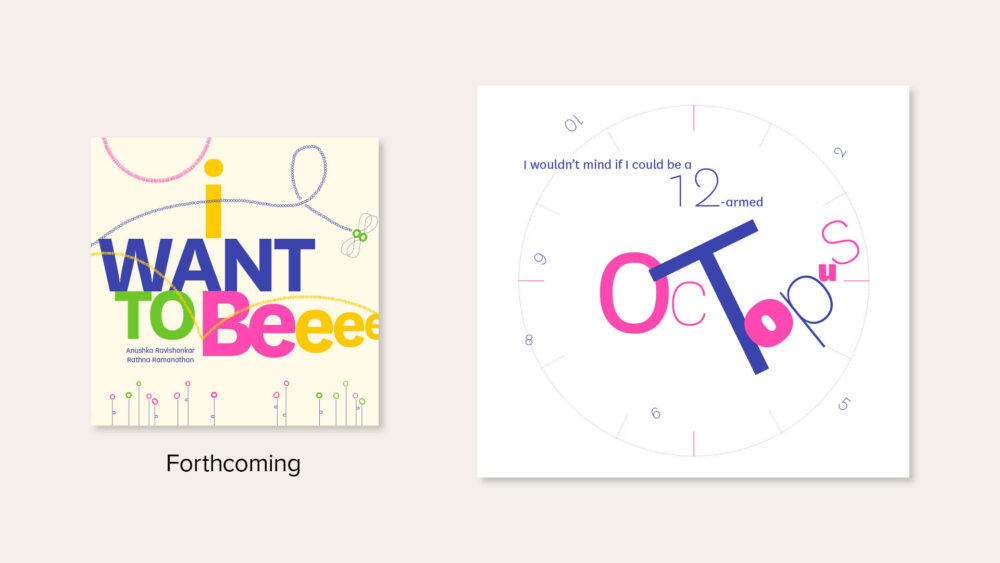
(Forthcoming) I Want to Be – A new and revised edition of Anything but a Grabooberry
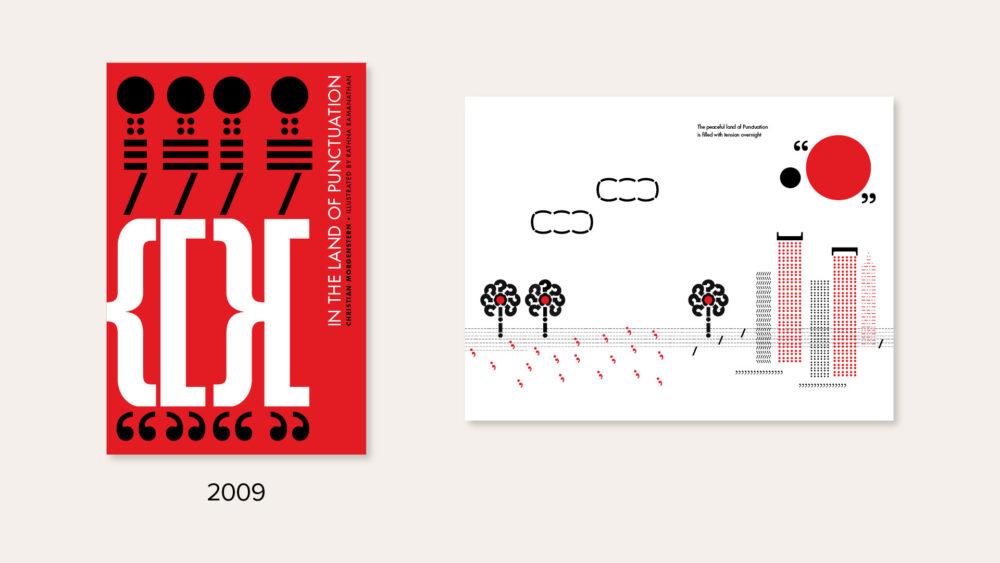
In the Land of Punctuation — German classic verse, where the designer turns illustrator, and type signs become images
Collective
The final — and possibly most important — aspect of our publishing vision is a firm belief in collaborative work. The creative people we work with outside of our organisation bring in dimensions we may never have thought of. On the other hand, in all these years, we’ve rarely received a manuscript that we can publish untouched. We work closely with authors and artists to turn their ideas into a book, or come up with an idea ourselves and find people to collaborate with. We began by following our instincts in an organic and inchoate way, but now it’s evident to us that what we’ve built is more akin to a creative book studio, rather than a publishing house in the conventional sense.
We started out as a group of people who brought in different skills and perspectives to the enterprise, and this collective ability has been our strength throughout. Evident in the books we’ve described so far, no project we’ve worked on can be credited to one person. Someone may have come up with an initial idea, but to turn it into a book needs a concept, text, images, editing, design and production — all these aspects are equally important. They sometimes need to be considered simultaneously — particularly since so many of our projects are unconventional, there are no given templates we can fall back on.
Initially, our way of functioning took collaborative labour for granted, as we went about solving issues as they came up. Over the years, we’ve taken a more planned and reflective approach, confident in the course correction that our collective guarantees. With experience, we’re able to be both founded and playful — all in the service of the book.
And in the final analysis, if we were to try to sum up what publishing has meant to us over these 28 years, and how we see our foreseeable future unfolding, we’d say our endeavour is to continue pushing the boundaries of a form that has endured for 500 years.
Gita Wolf started Tara Books, as an independent publishing house based in India. An original and creative voice in contemporary Indian publishing, Gita Wolf is known for her interest in exploring and experimenting with the form of the book and has written and over twenty books for children and adults. Several have won major international awards and been translated into multiple languages. Click here to discover Tara Books she has authored.
V. Geetha is a historian and translator and has been active in the women’s movement for over 3 decades. She has a special interest in pedagogy. Her work at Tara Books includes editing, writing, and working across different aspects of publishing to ensure that Tara’s publishing philosophy remains in focus, in all that they do.
Click here to discover Tara Books she has authored.


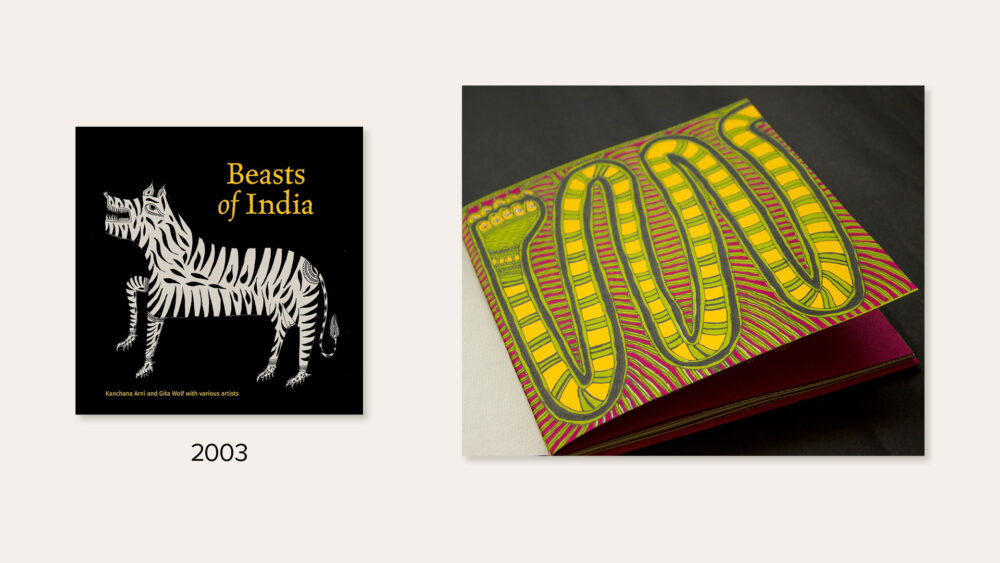
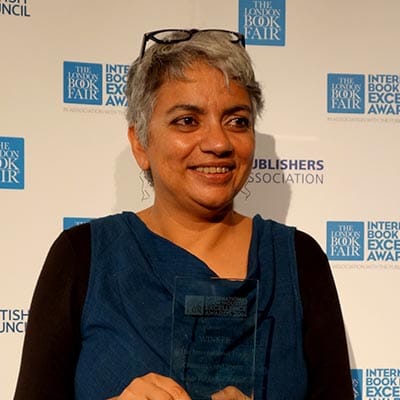

Richard Hardesty
Posted at 14:47h, 29 JulyI have the good fortune to have purchased two of your Greek plays. They are marvelous! I also recently re-read the excellent review you got back in 2010 in Parenthesis (#19, Autumn, pp. 7-9). I read it originally back then, but my interests at that time lay elsewhere. Having read it again, I must agree completely with it. You publish wonderful fine press books, and I recommend them whenever I get the chance. You have been the subject of discussion on the LibraryThing Fine Press forum: https://www.librarything.com/topic/342165 and https://www.librarything.com/topic/323076
I will, in time, add more of your fine books to my library/collection.
Keep up the excellent work!
The Tara Books Team
Posted at 12:18h, 02 AugustHi, Richard! Thanks for the lovely comment. We’re very happy to hear that you enjoy our books as much as we enjoy making them. Thanks for directing us to the discussion on the forum as well; it’s wonderful to see engaged readers share their thoughts on our books.
We’re truly grateful for all the support and encouragement we’ve received from readers like you—it’s what’s kept us going for all these years.